-
A Christmas Nursery
Even as a young child, Paul Pace was very fond of baby Jesus statues. Probably because they reminded him of a number of significant familial moments. His grandma gave him a small wax statue of baby Jesus in order to ease down his sorrow after his father George had to leave for a long time to work with the Navy. On another occasion, his father surprised him when he bought him an expensive statue of baby Jesus that he had longed for, after he succeeded to win a lottery. Now, at 69, Paul owns a collection of more than 2000 of such statues which he has lovingly gathered in a museum that he called ‘Il-Mużew tal-Bambini’.
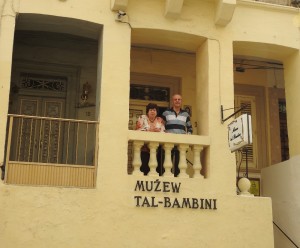 His wife Mary shares his passion and she is always present to give him a hand in this museum which they have purchased together.
His wife Mary shares his passion and she is always present to give him a hand in this museum which they have purchased together.“It is such a pleasure to see people getting emotional when they visit our museum. Some become very nostalgic as they remember their childhood. Others notice some statue which was similar to the one that their parents had, and they start recalling their memories. A number of visitors get inspired to buy a baby Jesus statue of their own, while some others decide to go home and search for their neglected antique statue which their grandma had left them,” Paul said.
Since its inauguration in 2010, il-Mużew tal-Bambini has become quite renowned both with the local and the foreign public. Although it is available for viewing by appointment throughout the year, most of the visitors attend to this museum during the Christmas season.
“There is always something new to see because we are continually adding to our collection. Even though by now, we have a problem with space, when we find a particular baby Jesus statue which we love, we just can’t help not to own it,” admitted Mary.
Certainly, the museum is a wonder to behold. The provenance of the statues is worldwide, thereby providing a rich overview of the different cultures. Skin colour, facial characteristics, and posture of these statues vary accordingly.
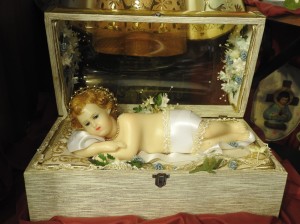 A delicate looking baby Jesus which was made in Malta, rests in a musical box and moves his eyes and hands. A dark skinned baby Jesus made from wood in Tanzania looks exotic amongst the others. A curly black-haired toddler Jesus, wearing the traditional costume of Perù, sits on a chair and weeps after stepping on a thorn, according to a local legend. A wooden statue from Betlehem shows Jesus as a boy dressed as a king and sitting on an elegant throne. A teenage Jesus from Atocia is also resting on a chair, but this time, he wears the clothes of a pilgrim and carries a rod. An intricately adorned statue of Jesus from Trapani is embellished with pomegranate for good luck.
A delicate looking baby Jesus which was made in Malta, rests in a musical box and moves his eyes and hands. A dark skinned baby Jesus made from wood in Tanzania looks exotic amongst the others. A curly black-haired toddler Jesus, wearing the traditional costume of Perù, sits on a chair and weeps after stepping on a thorn, according to a local legend. A wooden statue from Betlehem shows Jesus as a boy dressed as a king and sitting on an elegant throne. A teenage Jesus from Atocia is also resting on a chair, but this time, he wears the clothes of a pilgrim and carries a rod. An intricately adorned statue of Jesus from Trapani is embellished with pomegranate for good luck.“Our interest in this aspect has led us to travel to countries which are related to the life of Jesus, and from which we knew that we could find such statues. Our visit to the Holy Land was an incredible experience which gave us the opportunity to walk in the same roads where Jesus lived. Moreover, it was an ideal country from where to acquire some beautiful statues for our collection,” remarked Paul.
“When we visited Prague, we bought 42 different baby Jesus statues!” exclaimed Mary.
 They just had to, they explained, as they saw my startled reaction. This was because according to an old tradition, the statue of baby Jesus in Prague is dressed in different coloured clothes each day. Therefore, they were bound to purchase a number of statues which showed Jesus in several dresses. Nevertheless, not all the statues bought ended up in the museum, since some of these were presents for family members and friends.
They just had to, they explained, as they saw my startled reaction. This was because according to an old tradition, the statue of baby Jesus in Prague is dressed in different coloured clothes each day. Therefore, they were bound to purchase a number of statues which showed Jesus in several dresses. Nevertheless, not all the statues bought ended up in the museum, since some of these were presents for family members and friends.“Many of those who visit our museum are curious to know whether we can remember all our statues, which of course, we do. We can also recall all the places from where we have obtained these items. Each statue has an interesting story behind it and we love to share them with whoever’s interested to listen,” Paul said.
I was all ears and I felt simply fascinated when their narrative started to pour in. One of these stories entailed how they managed to buy a statue of baby Jesus which belonged to St. Ġorġ Preca. Another was related to an excellent bargain which Mary made unknowingly, when she bought a statue for her husband for a low price, and then found out that it dated to the 18th century. I loved also the account relating to a particular container made of mica which was produced in Malta by a German prisoner of war during World War II, and was utilized to hold a statue of baby Jesus.
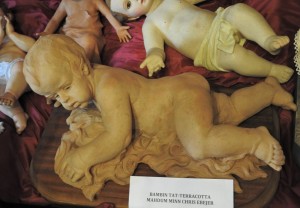 “We have many antique statues but the oldest one that we know the date of goes back to 1730. The smallest statue is about 15mm long, whereas the largest one has a length of 80cms. The materials of these statues varies widely and include: stone, alabaster, marble, woods of different kinds, wax, ceramic, concrete, lava, straw, plastic, wool, and even bull’s horn,” Mary explained.
“We have many antique statues but the oldest one that we know the date of goes back to 1730. The smallest statue is about 15mm long, whereas the largest one has a length of 80cms. The materials of these statues varies widely and include: stone, alabaster, marble, woods of different kinds, wax, ceramic, concrete, lava, straw, plastic, wool, and even bull’s horn,” Mary explained.Yet the strangest was yet to come…
“One day, we had a statue which lost its synthetic hair and we decided to try to replace it with some hair of one of our daughters. The experiment succeeded and soon, we provided the hair to a number of other statues by trimming some hair from our other daughter and eventually also from that of our nephews,” smiled Paul as he pointed them out proudly.
Each time that I observed the statues, I noticed a different one which I had not seen before. The collection looked literally endless, and yet each statue was unique. Whilst some of the statues showed simple features, mostly due to the artistic fashion of the time, others were quite elaborate and pretty. Yet there were also a number of outstanding characters which stood out from the rest.
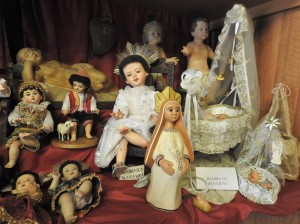 “The main aim of this museum is to share the sweetness of Christmas and the joy which is inherent in each statue of baby Jesus,” revealed the couple.
“The main aim of this museum is to share the sweetness of Christmas and the joy which is inherent in each statue of baby Jesus,” revealed the couple.However, this place offers much more than that since it nurtures love for one’s family, whilst it cherishes an appreciation for diversity. Undoubtedly, this collection is also an invaluable source for those who are interested to study the changes which took place along the years in the production of such precious artworks.
Il-Mużew tal-Bambini which is located at 17, Triq Santa Tereża, Birkirkara, will be open for the public from Sunday, 13th December 2015 to Wednesday, 6th January 2016.
Opening times: Monday to Saturday from 4:30pm – 8:00pm, Sundays and Public Holidays from 9:00am – noon and from 4:30pm – 8:00pm. For more information, one can call 21492111.
(This article was published in CHRISTMAS TIMES Suppliment issued with The Times of Malta dated 8th December 2015)
-
Bats at the museum
As the sun began to set, the sky darkened with the legion of bats which came out of the Rabat catacombs, noted G. Gulia in 1890 in his book Elenco dei Mammiferi Maltesi. Certainly, the tendency of these nightly creatures to live in such dreaded underground areas didn’t help them much in order not to be associated with evil and darkness. Likewise, their strange semblance, their mythical association with Dracula, and images of Satan bearing their wings, hindered even more their reputation. In Aztec and Mayan cultures, bats were deities connected to death. Yet nothing could be far from the truth since bats have a beneficial role in the earth’s ecosystem.
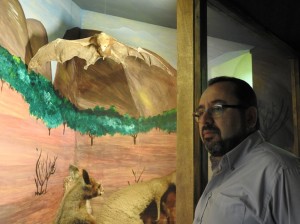 The importance of these unique flying mammals was highlighted during a recent activity which was organized by MEPA’s Environment Division in collaboration with Heritage Malta, at the National Museum of Natural History in Mdina. This annual event, recognized as Malta Bat Night, included a discussion about bats and listening to their sounds through an electronic device.
The importance of these unique flying mammals was highlighted during a recent activity which was organized by MEPA’s Environment Division in collaboration with Heritage Malta, at the National Museum of Natural History in Mdina. This annual event, recognized as Malta Bat Night, included a discussion about bats and listening to their sounds through an electronic device.“Malta Bat Night forms part of a partnership which we have with the European Union for the Research and Conservation of Bats,” explained John Joseph Borg, Senior Curator at the National Museum of Natural History.
“Such events are aimed to inform the public about bats in the hope of removing the negative impression that people have about them. Along the years, bats have decreased considerably in Malta, both because their habitat has often been disturbed, and also due to direct acts of vandalism which were carried out upon them.”
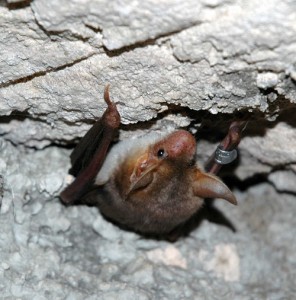 Indeed, Borg explained that colonies of bats have been repeatedly put on fire whilst they were resting in their caves. Others were smothered when vandals threw mud and other things at them, even though they were clearly being protected behind a gate, such as in the case of Ħasan Cave. Bats of a small colony which lived in a site that had access to a particular school, were burnt alive by school children after they captured them and drenched them in hot candle wax.
Indeed, Borg explained that colonies of bats have been repeatedly put on fire whilst they were resting in their caves. Others were smothered when vandals threw mud and other things at them, even though they were clearly being protected behind a gate, such as in the case of Ħasan Cave. Bats of a small colony which lived in a site that had access to a particular school, were burnt alive by school children after they captured them and drenched them in hot candle wax.Well, after hearing these stories, it becomes very clear who the evil ones are.
“Unfortunately our culture has taught us to fear and hate these creatures. In actual fact, their presence could be very advantageous to humans,” revealed Borg.
“Many of the bats eat insects and studies have shown that they tend to feed on species that are harmful to humans and to agriculture. Other small bats which have an elongated snout and a long tongue, act as pollinators when they enter into flower tubes to lick the pollen inside and then move onto different plants. Larger bats, which may look spooky and scary, nurture themselves on decaying fruit and therefore, they keep the fruit trees healthy.”
What about the so called vampire bats. Were they real? And do we have them in Malta?
 “In contrast to peoples’ impression that all bats can suck blood, most of them thrive on insects, fruit, fish and frogs. The only vampire bats which feed on blood are found in South America and they are pretty small. They are nothing similar to the fictional bats that we see in films. In fact, they do not suck blood but they lick it, thanks to their anticogulant saliva which prevents the blood from clotting. They do not normally attack human beings and neither animals. However, they will feed on any animal available if it is reachable to them, including humans.”
“In contrast to peoples’ impression that all bats can suck blood, most of them thrive on insects, fruit, fish and frogs. The only vampire bats which feed on blood are found in South America and they are pretty small. They are nothing similar to the fictional bats that we see in films. In fact, they do not suck blood but they lick it, thanks to their anticogulant saliva which prevents the blood from clotting. They do not normally attack human beings and neither animals. However, they will feed on any animal available if it is reachable to them, including humans.”Borg informed me that we have seven resident species of bats which are: Lesser Horse-shoe Bat (Rhinolophus hipposideros), Maghrebian Bat (Myotis punicus), Grey Long-eared Bat (Plecotus austriacus), Savi`s Pipistrelle (Hypsugo savii), Kuhl`s Pipistrelle (Pipistrellus kuhlii), Common Pipistrelle (Pipistrellus pipistrellus), and Soprano Pipistrelle (Pipistrellus pygmaeus).
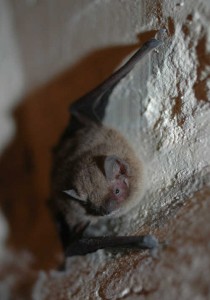 “We have bats from all these resident species living in this museum,” smiled Borg who has an avid passion about bats. “In the underground tunnels there are the Lesser Horse-shoe and the Maghrebian Bats, whereas in the rooms of the underlying level, one finds the Grey Long-eared and the Lesser Horse-shoe Bats. Moreover, all the four Pipistrelle species have managed to make a home in some cracks of the facade and on the high beams.”
“We have bats from all these resident species living in this museum,” smiled Borg who has an avid passion about bats. “In the underground tunnels there are the Lesser Horse-shoe and the Maghrebian Bats, whereas in the rooms of the underlying level, one finds the Grey Long-eared and the Lesser Horse-shoe Bats. Moreover, all the four Pipistrelle species have managed to make a home in some cracks of the facade and on the high beams.”From the remains of moth wings which Borg collects from the museum floor early in the morning for his studies, he is able to identify more information about his resident bats, such as what they prey on. Interestingly, each small Pipistrelle is able to eat around 20,000 moth each night, thereby being more effective than the insect sprays which we use. Nonetheless, most people have no idea about this and when they realize that they are co-habitating with bats, hell breaks lose.
“We do receive calls from people who request us to remove bats from their properties. It is very rare that these creatures enter into homes. Usually they live in cracks in external windows or in narrow openings in facades. Some of the bats are minute in size and in fact, five of them can be placed in a matchstick box. Generally, once these people realize that these animals will be doing no harm to them or to their family, they will agree to allow them to stay. Yet there were cases when the individuals concerned were adamant that they wanted them removed.”
 In such cases, Borg or other responsible officials will need to go and survey the bats before taking action. This involves counting them daily for a whole week in order to confirm the exact amount of bats that are roosting in this place. Once, this amount is identified, they will wait until all the bats are out at night and then they will block the nest in order not to let them in again. Eventually, when the bats will return home and realize what happenned, they will automatically move away to a second area which they tend to keep as a form of protection.
In such cases, Borg or other responsible officials will need to go and survey the bats before taking action. This involves counting them daily for a whole week in order to confirm the exact amount of bats that are roosting in this place. Once, this amount is identified, they will wait until all the bats are out at night and then they will block the nest in order not to let them in again. Eventually, when the bats will return home and realize what happenned, they will automatically move away to a second area which they tend to keep as a form of protection.“This procedure to count bats is very important because they do not always leave the nest in the same number. Usually, a scout bat will fly out first in order to check whether it is windy and whether there are enough insects available in the area. If he returns, the others will stay inside but if he does not, they will understand that the situation is favourable and they will fly out too.”
I couldn’t help feeling impressed by these creatures. Yet more was still to come.
 “The courting and copulation of bats takes place in autumn, between October and November. Then, as soon as the temperature drops and insects are more rare, they will fall in a state of torpidity which is a short period of sleep. During this time, the sperm with which the female has been fertilized will remain stored inside her, waiting for the right moment to come. Once the tempertaure gets warmer and insects become available, these bats will wake up and the real preganancy will start. In this way, both the mother and the offspring will have a better chance to survive.”
“The courting and copulation of bats takes place in autumn, between October and November. Then, as soon as the temperature drops and insects are more rare, they will fall in a state of torpidity which is a short period of sleep. During this time, the sperm with which the female has been fertilized will remain stored inside her, waiting for the right moment to come. Once the tempertaure gets warmer and insects become available, these bats will wake up and the real preganancy will start. In this way, both the mother and the offspring will have a better chance to survive.”Although there are some who associate bats with flying mice, Borg informed me that there is nothing common between the two. While mice come from the order Rodentia, bats form part of the order of Chiroptera (meaning hand-wing).
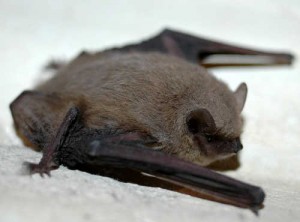 “The oldest bat fossils date back to 55 million years ago where this mammal had already the shape which we know today. On the other hand, the oldest fossils which were found in Malta go back to the Ice Age at around 200,000 and 10,000 years ago. These were found during excavations at Għar Dalam and so we can say that these ancient bats remember the dwarf elephants and hippopotami roaming around. At this museum, we do hold a sample of these fossils. However, the majority of them were taken by the foreign researchers who were doing the excavations, and these passed on their discoveries to their relative museums.”
“The oldest bat fossils date back to 55 million years ago where this mammal had already the shape which we know today. On the other hand, the oldest fossils which were found in Malta go back to the Ice Age at around 200,000 and 10,000 years ago. These were found during excavations at Għar Dalam and so we can say that these ancient bats remember the dwarf elephants and hippopotami roaming around. At this museum, we do hold a sample of these fossils. However, the majority of them were taken by the foreign researchers who were doing the excavations, and these passed on their discoveries to their relative museums.”In the Mdina museum, one can also find some current bat specimens. Borg insisted that it is not the policy of the museum to capture and kill creatures in order to preserve them. So, one won’t find a specimen for each species which live in Malta. Nevertheless, the museum will do his best to assist whoever will request information about bats.
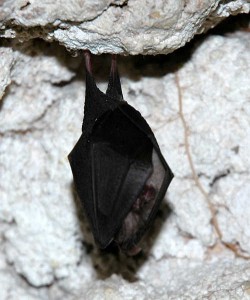 Borg’s own interest in bats goes back to the 1980s. Originally fearful of them, he came face to face with these bats whilst he was doing bird studies and these nightly creatures were being captured accidentally in nets. At first nervous, he asked others to remove them for him, until one day, he decided to do the job himself.
Borg’s own interest in bats goes back to the 1980s. Originally fearful of them, he came face to face with these bats whilst he was doing bird studies and these nightly creatures were being captured accidentally in nets. At first nervous, he asked others to remove them for him, until one day, he decided to do the job himself.From then on, he was completely captivated by them and has been studying them ever since, eager to share his knowledge in the hope of fostering more interest from the public.
It is safe to say that Malta Bat Night has certainly gone a long way towards achieving this.
(This article was published in Escape Suppliment issued with the Sunday Times of Malta dated 29th November 2015)
-
IN SICKNESS AND IN WEALTH
Although today, many societies relate marriage to two persons falling in love with each other, in the past, matters were quite different. Some of the local marriages, especially in wealthy families, were pre-arranged at age seven, in order to ensure that the children will marry a partner at par or even one which could enhance their title and possessions.
Parents were expected to provide their daughters with a dowry as a form of marriage payment and at times, as a kind of anticipated inheritance. Generally depending on the couples’ status and on the type of marriage contract which they adopted, this dowry could either serve to assist the newly-wed to establish a new household, or else to act as a mode of protection against the possibility of ill treatment to the bride by her husband and his family, since in the latter cases, the dowry might have to be returned back. A dowry offered also an element of financial security in widowhood, particularly if there were little children in the family.
The Notarial Archives in Valletta possess a treasure trove of stories connected to marriages and dowries of the past. Thick manuscripts with remarkably detailed records of people who lived hundreds of years ago, encapsulate these significant moments in the elegant writing in black ink and brings them back to life, each time someone opens the old pages and reads.
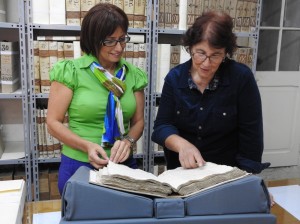 “One of the earliest contracts of marriages which one can find at these archives is dated to 1467. In it, Zullus Calleja from Naxxar is listing the objects which he is forwarding to the groom as a dowry in name of his daughter Jacoba. The form of this dowry is alla Maltese, and that means that the future husband will only be able to administer these possessions but not to sell them without his wife’s consent. However, once their children are born, this dowry will automatically be divided into three equal parts; one belonging to the husband, the other to the wife, and the rest to the offspring. Nevertheless, the children will not be able to utilize these belongings until they reach age 15,” revealed historian Dr Joan Abela.
“One of the earliest contracts of marriages which one can find at these archives is dated to 1467. In it, Zullus Calleja from Naxxar is listing the objects which he is forwarding to the groom as a dowry in name of his daughter Jacoba. The form of this dowry is alla Maltese, and that means that the future husband will only be able to administer these possessions but not to sell them without his wife’s consent. However, once their children are born, this dowry will automatically be divided into three equal parts; one belonging to the husband, the other to the wife, and the rest to the offspring. Nevertheless, the children will not be able to utilize these belongings until they reach age 15,” revealed historian Dr Joan Abela.Together with Isabelle Camilleri, a diligent worker at the Notarial Archives, Abela prepared a display of manuscripts pertaining to different eras so that I could analyze the interesting data within.
“Whilst I was doing some research about marriage contracts in the old days, I discovered that much of them included also a section marked as dos which related to the dowry being given by the father to the groom. Some of these dowries formed part of the inheritance of the bride and therefore it was declared in the contract that the amount which was being given to her during marriage, would be eventually decreased once she inherits her deceased parents. On the other hand, some contracts stated that this dowry was being donated over and above the future inheritance that the woman will have,” explained Abela.
This study shed light also on different types of dowry contracts which were in existence at the same time during various periods.
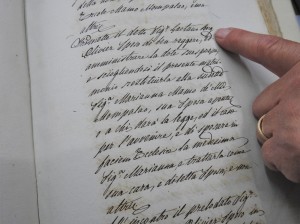 “The most popular ones were the contracts that used the alla Greca or the alla Romana custom, which were practically the same thing. Basically, this type of contract stipulated that all the dowry which was forwarded by the bride’s father to the groom could only be administered by the latter but it could never be alienated without his partner’s approval.”
“The most popular ones were the contracts that used the alla Greca or the alla Romana custom, which were practically the same thing. Basically, this type of contract stipulated that all the dowry which was forwarded by the bride’s father to the groom could only be administered by the latter but it could never be alienated without his partner’s approval.”No matter which style was chosen, all these dowry contracts were quite formal and organized. Experts in each sector of the items being included in the dowry were called upon to evaluate these objects professionally, and their names were included in the contract as a guarantee of genuinity. Ultimately, each of these things were described meticulously in the contract, together with their value at the time.
“Each time that I am working on a new manuscript, I am often delighted at the descriptions that I find. They are so rich in detail that I get the impression of seeing or touching the materials being mentioned, or of smelling the scents and perfumes of the objects in question. I find myself literally in another world as I delve through these pages and read the lists of things that this bride carried with her to her new home,” Camilleri said.
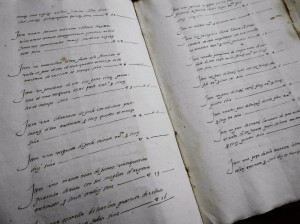 Dowries of affluent people could be quite impressive. One of these which was in the alla Romana style, had a list of more than 60 objects and was dated to 1557.
Dowries of affluent people could be quite impressive. One of these which was in the alla Romana style, had a list of more than 60 objects and was dated to 1557.“There is so much to ponder in this contract,” remarked Abela. “The one who was making the dowry was the renowned knight Marshall Fra Guglielmo Couppier who took part in the Great Siege of Malta in 1565. Interestingly, Victoria, the bride, had been Couppier’s slave but he had given her freedom. Moreover, in this contract, he was also forwarding a substantial dowry in her name, worth of a highly noble woman, to her future husband Hieronomu Debonè who worked as a bombardier and blacksmith.”
Victoria’s dowry included a 20 year old black male slave and a 59 year old female slave, refined jewelry made of gold, precious stones and pearls, clothes made from the most costly materials such as silk, velvet and wool, and mattresses, pillows, bedsheets and blankets of the finest luxury.
“Another type of dowry contract that was available was known as alla Latina. I didn’t find many of these and I noticed that generally they were used by peasants or families who were not so well-off. In fact, the main aim of such contracts was to help the couple initiate a new life together, since otherwise, this would have been difficult. The agreement in such contracts stated that after a year from their wedding, whatever the couple owned, including the dowry which the bride had brought with her, would belong to both of them. And once children were born, these possessions would be divided into three equal parts between the husband, wife and offsprings.”
Unlike the other types of dowry contracts wherein the husband was bound to return all the dowry objects to his wife’s father, in the same good state, or even better, should their marriage fail for any reason or if the woman died before having any children, the couple which chose the alla Latina contract shared both the good and bad times together.
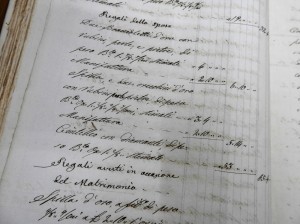 Camilleri led me to another manuscript which dated to the 1860 wherein she showed me a long contract that incorporated an inventory of the dowry of a woman who had died and left three small children behind. Her husband was going to get married a second time and so it was required to specify exactly the origin and value of the deceased wife’s possessions.
Camilleri led me to another manuscript which dated to the 1860 wherein she showed me a long contract that incorporated an inventory of the dowry of a woman who had died and left three small children behind. Her husband was going to get married a second time and so it was required to specify exactly the origin and value of the deceased wife’s possessions.“This dowry included also the gifts which she was given during her wedding,” highlighted Camilleri. “Jewelery made the best part of it and it comprised items made of gold, precious stones, pearls and diamonds. Who gives these gifts in weddings nowadays?”
Up to some years ago in Malta, dowries were still handed over to the newly married couple. Most of these couples were provided with practical items which would be useful in their new home, although some admit that they were given so many things that it was hardly possible to use all of them. In fact, a number of them were still lying in cupboards, brand new.
Although one might still encounter a few Maltese couples from the younger generation whose families are adamant to keep this custom alive, the tradition of providing a dowry of goods is certainly dying out. Yet I tend to believe that the dowry itself has not become obsolete but has merely changed form, possibly into money which could be used by the couple to buy a property or to finance their wedding reception.
(This article was published in the Weddings Supplement issued with The Times of Malta of November 4, 2015)
-
A HIDDEN BEAUTY SPOT
In contrast to the city of Beijing, wherein we visited some of the most splendid sites of Chinese historical significance, Shanghai seemed bound to impress us with its ultra modern, cosmopolitan character and its new high rises. Even though we were informed that a number of old structures in Shanghai were being preserved in order to conserve the roots of this area, our initial general impression was that the new buildings had taken over considerably its Chinese origins.
 Therefore, it was quite a pleasant surprise to learn that tucked safely away at relatively short distances from this avant-garde city, one could still find a wide selection of ancient water towns which offer the opportunity to relish the charm of an ancient China. Known as the ‘Little Venices of the East’, these unique towns of exceptional allure are a wonder of cultural landscape. A visit to at least one of them, is definitely a must once you are in Shanghai.
Therefore, it was quite a pleasant surprise to learn that tucked safely away at relatively short distances from this avant-garde city, one could still find a wide selection of ancient water towns which offer the opportunity to relish the charm of an ancient China. Known as the ‘Little Venices of the East’, these unique towns of exceptional allure are a wonder of cultural landscape. A visit to at least one of them, is definitely a must once you are in Shanghai.Since we had only one day left in Shanghai, our guide led us to Zhujiajiao which is located only forty seven kilometers away from this city, in the district of Qingpu. With a history of around 1700 years, Zhujiajiao is renowned as one of the best preserved ancient water towns of the area. Like much of the other sites in China, once we got there, we found the place pretty crowded, especially since on that day, the local people were celebrating the Mid-Autumn Festival. Indeed, during public holidays, these water towns are very popular with Shanghai residents who yearn for moments of tranquility, away from the hustle and bustle of the urban areas.
 The settlement of Zhujiajiao dates back to the Yuan dynasty, when this location was turned into an important trading hub for the surrounding countryside. Since it is strategically situated at the intersection of a number of local rivers, Zhujiajiao continued to gain significance, and during the reign of Emperor Wanli of the Ming dynasty, it was granted township status. The town prospered by trading rice and cloth which were transported on boats from the surrounding countryside, right to the houses of the Zhujiajiao merchants.
The settlement of Zhujiajiao dates back to the Yuan dynasty, when this location was turned into an important trading hub for the surrounding countryside. Since it is strategically situated at the intersection of a number of local rivers, Zhujiajiao continued to gain significance, and during the reign of Emperor Wanli of the Ming dynasty, it was granted township status. The town prospered by trading rice and cloth which were transported on boats from the surrounding countryside, right to the houses of the Zhujiajiao merchants.Today, this town which covers about 3 square kilometers, has a population of about 70,000 people. Although nowadays, one finds some recent and modern structures in Zhujiajiao, about a thousand of the surviving buildings and ancient markets were constructed during the Ming and Qing dynasties.
 Thirty six bridges of different sizes, designs, and materials, cross the small rivers shaded by willow trees, and connect the ancient town. Whilst the narrowest bridges are only about a metre wide, Zhujiajiao can boast to have the largest stone arch bridge in Shanghai. Originally built in 1571 by the monk Xingchao of Cimen Temple in 1571, and then rebuilt in 1812, Fangsheng Bridge rests on five arches and is 70 metres long, and 5.8 metres high. The central arch is decorated with a stone relief of eight dragons surrounding a pearl, whilst the pillars at the ends are sculpted into lions.
Thirty six bridges of different sizes, designs, and materials, cross the small rivers shaded by willow trees, and connect the ancient town. Whilst the narrowest bridges are only about a metre wide, Zhujiajiao can boast to have the largest stone arch bridge in Shanghai. Originally built in 1571 by the monk Xingchao of Cimen Temple in 1571, and then rebuilt in 1812, Fangsheng Bridge rests on five arches and is 70 metres long, and 5.8 metres high. The central arch is decorated with a stone relief of eight dragons surrounding a pearl, whilst the pillars at the ends are sculpted into lions.Interestingly, ancient bridges can be recognized from more recent ones by looking at the height of their stairs, since in the old days, these were quite steep, whereas nowadays, steps are constructed in lower and more uniform positions, in order to be more easily accessible, especially to the elderly.
 Both these bridges and the town itself can be appreciated further by taking a cruise on one of the small bamboo gondolas that navigate the countless waterways of Zhujiajiao. A short trip and a longer one are offered, wherein the first takes passengers up and down the main canal, whilst the latter travels all over the town and back.
Both these bridges and the town itself can be appreciated further by taking a cruise on one of the small bamboo gondolas that navigate the countless waterways of Zhujiajiao. A short trip and a longer one are offered, wherein the first takes passengers up and down the main canal, whilst the latter travels all over the town and back.In order to explore this town, one needs about four hours. Narrow streets filled with different shops that sell typical souvenirs and various other products are often packed with tourists who tend to disrupt the serenity that one would have expected to find in such a location. The one kilometre North Streetis the best preserved ancient street in this suburb where one can observe the historical architecture. On the other hand, in Xijin Street, one can visit the classical Kezhi Garden with its distinguished combination of traditional Chinese and Western styles.
 A closer investigation of Zhujiajiao can offer much more to see, includingTongtianhe Medicine Shop, Qing Dynasty Post Office, Baoguo Temple, and Yuanjin Meditation Room. A selection of bars, restaurants, teahouses, and coffee shops provide the opportunity to rest and to taste some local cuisine whilst gazing out at the rivers or the main canal.
A closer investigation of Zhujiajiao can offer much more to see, includingTongtianhe Medicine Shop, Qing Dynasty Post Office, Baoguo Temple, and Yuanjin Meditation Room. A selection of bars, restaurants, teahouses, and coffee shops provide the opportunity to rest and to taste some local cuisine whilst gazing out at the rivers or the main canal.Having gone through a period of inactivity, where life crawled on at a slow pace, in these last years Zhujiajiao has gone through a rapid transformation as both locals and foreigners began to long for such preserved gems which can relate strongly to a bygone period in China.
Although some believe that the heavily touristic element on which the inhabitants have become highly dependent, is ruining the romantic nature of this sublime ancient water town, I can say that I enjoyed every minute which I spent in this exotic place. A heaven for photographers, Zhujiajiao provides an unforgettable experience of a surreal Chinese life which has succeeded to endure the test of time.
(This article was published in ESCAPE Suppliment which was issued with the Sunday Times of Malta dated 1st November 2015)
-
AROUND THE WORLD IN 90 DAYS
“They say that you always travel three times: the first time when you are planning your holiday,then when you actually travel, and finally when you watch the photos that you have taken whilst travelling,” Jennifer told me as she proudly showed me the pictures that she and her husband Alan took during their three month honeymoon trip around the globe.
Since Alan Borg and Jennifer Cusba got to know each other, their life turned into an adventure. They met incidentally on a boat trip whilst they were visiting the enchanting lakeside town of Guatapé in Colombia.
 “I was on holiday in Colombia with my friends, when we decided to go on this particular boat trip. At one point, I saw Jennifer walking by with her mother and I liked her immediately. So I followed her, waiting for an excuse to talk to her. The right moment came when I noticed that she needed someone to take their photo and I offered to help. Then, I made sure to take a photo with her too,” revealed Alan.
“I was on holiday in Colombia with my friends, when we decided to go on this particular boat trip. At one point, I saw Jennifer walking by with her mother and I liked her immediately. So I followed her, waiting for an excuse to talk to her. The right moment came when I noticed that she needed someone to take their photo and I offered to help. Then, I made sure to take a photo with her too,” revealed Alan.For the following three months, they kept in contact through Facebook. During one of their communications, Jennifer who is Colombian, told Alan that she was planning to go to America to study English.
“I lived in Bogotá, the capital city of Colombia, where I worked as an internal auditor of a governmental company. I had studied hard to obtain this job and in the first years, I was very satisfied that I had succeeded in this career. However, as time went by, I felt that life had become stale. I woke early each day to travel for two hours to reach work, meeting always the same people on the bus and at work, and likewise on my two hour ride back home. At 29 years, I felt as if I was stuck in a rut and I was afraid that if I continued to live this mundane life, I would lose all the essence of life. I definitely had to do something to make a change,” reminisced Jennifer.
Once again, Alan did not fail to grab the opportunity, and as soon as he learnt that Jennifer wanted to study English, he informed her about the selection of English schools that there were in Malta. Attracted by Alan’s gentle and friendly attitude, and also by the fact that it was cheaper to study in Malta than in America, Jennifer chose the small archipelago of the Maltese Islands. Once in Malta, their friendship grew stronger, she gave up her job in Colombia, and a year later, they got married.
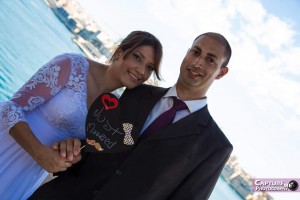 “When we told our friends and relatives that we were going to get married, they all wanted to know when and where the wedding is going to take place and how many guests would be invited. However, we had no intention of spending thousands of euros for just a few hours of enjoyment. Our plans were much bigger!” claimed Alan.
“When we told our friends and relatives that we were going to get married, they all wanted to know when and where the wedding is going to take place and how many guests would be invited. However, we had no intention of spending thousands of euros for just a few hours of enjoyment. Our plans were much bigger!” claimed Alan.“On our wedding day we were joined by our family and closest friends. After the celebration, we shared a cake, drank some champagne, took photos, had a lot of fun, and that was that. The big moment came seven months later, when we prepared our backpacks and left for the adventure of a lifetime,” continued Jennifer.
Alan decided to make the best of the various offers and discounts that his job with an airline company afforded him. The couple started out with an initial idea of a simple honeymoon to Santorini, fully aware that they’d need to get a connecting flight from another location. Soon, this stopover was joined by other countries until the list grew and grew. Eventually, they decided to go on a three month trip around the world, to the total tune of 15,000 euros.
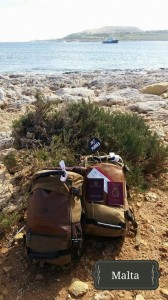 “We both love to travel. Yet I was the one who was more experienced in travelling to faraway countries without concerning myself too much on a fixed itinerary. In fact, at first, Jennifer was somehow incredulous whether this voyage would take place for real,” smiled Alan.
“We both love to travel. Yet I was the one who was more experienced in travelling to faraway countries without concerning myself too much on a fixed itinerary. In fact, at first, Jennifer was somehow incredulous whether this voyage would take place for real,” smiled Alan.“It’s true! I was worried whether we would have enough money to do it all and what would happen if we spent everything whilst still abroad? I was also afraid that someone could steal our cards or that unknowingly, we could end up in some dangerous country or get caught up in a terrorist attack.”
In reality, during this amazing voyage, the couple did have their fare share of risk… In New York, they experienced a huge storm and they could not get out of their hotel room. In Colombia, whilst they were seeing a horseshow, an earthquake shook the building which they were in. In Australia, just a week after they left, the Central Coast was a complete disaster with houses being carried away due to heavy floods and strong winds.
“Before we left on our adventure, I left a simple message on Facebook saying that we were going on our honeymoon, never mentioning that we were going for a trip around the world, because I couldn’t believe it myself! Off we went to Amsterdam and then we started to move and move and move, until I realized that this dream was becoming true. It became very very real whilst we were on the long flight crossing from Australia to Japan, and I started to note the various countries showing on the screen in front of me. By then, we had been to many of them, changing even continents, and there it dawned on me that we were truly going around the world,” Jennifer exclaimed.
 Although they had planned an overall general itinerary of the places and sites which they wished to visit, they prebooked nothing except their first destination to Amsterdam. And yet, they managed to see and do many many things. Their travels took them to Amsterdam, New York, Las Vegas, Arizona, San Francisco, Mexico, Brazil, Colombia, Peru, Chile, Sydney, New South Wales, Melbourne, Queensland, Japan, and Istanbul.
Although they had planned an overall general itinerary of the places and sites which they wished to visit, they prebooked nothing except their first destination to Amsterdam. And yet, they managed to see and do many many things. Their travels took them to Amsterdam, New York, Las Vegas, Arizona, San Francisco, Mexico, Brazil, Colombia, Peru, Chile, Sydney, New South Wales, Melbourne, Queensland, Japan, and Istanbul.“Ultimately, this was not just a holiday but an experience. Certainly, quite a great way to start a new and exciting chapter as husband and wife,” beamed Alan as he winked at Jennifer.
(This article was published in ‘Escape’ cultural suppliment issued with the Sunday Times of Malta dated 4 October 2015)
-
IF THESE WALLS COULD TALK
450 years ago, the Maltese Islands were in the spotlight of several European sovereigns after they had succeeded to come out victorious from the massive siege that was laid upon them by the powerful Ottoman Empire. Fort St Elmo lay in ruins and the other fortifications and houses which had been targeted by the enemy were in no better shape. The land still seeped in the blood of the thousands who had lost their lives during the fighting, whilst many others remained maimed.
Amid this devastation, the eminence of the surviving Knights of the Order of St John surged, and their fame reached legendary proportions. Letters of congratulations which they received from all over Europe, uplifted their spirits, whilst generous donations eventually helped them to build the new city of Valletta.
The Knights of St John continued to rule the Maltese Islands until 1798, when they were ousted by French Military General, Napoleon Bonaparte. Although, some might believe that at this time, the Order was obliterated, in reality, these mythical Hospitallers are still present amongst us, and are as real as ever.
The Russian Grand Priory of Malta
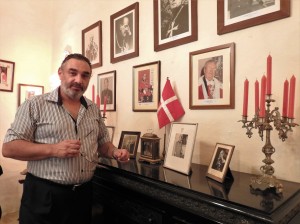 Since the early years of the Hospitallers’ foundation by Blessed Gerard, the Order protected the faithful and provided aid to the sick and poor. These elements have always remained deeply rooted in the mission of the knights who followed throughout the centuries.
Since the early years of the Hospitallers’ foundation by Blessed Gerard, the Order protected the faithful and provided aid to the sick and poor. These elements have always remained deeply rooted in the mission of the knights who followed throughout the centuries.“Even today, as Knights and Dames of the Russian Grand Priory of Malta who form part of the Order of St John of Jerusalem, Knights Hospitallers, under the constitution of the late King Peter II of Yugoslavia, we strive to continue to live up to our motto “Pro Fide, Pro Utilitate Hominum,” declared Chev. Saviour Garcia as we stood in front of a large painting of Blessed Gerard at Palazzino Sapienti in Valletta.
“Today, the Order’s mission still incorporates the duty to profess the Christian faith. However, its present members are not fighters but humanitarians who swear to act for the common good of all people without distinction of race or religion.”
Garcia outlined a number of philantropic projects which the Russian Grand Priory of Malta have been taking care of without much pomposity. Amongst these he mentioned St Joseph’s Residential Home for children in Żabbar, Dar Nazareth’s Residential Home for people with disability in Żejtun, and the construction of a hospital and a hostel in Thailand which caters for the needs of dying children with AIDS.
“The first investiture and the official institution of The Malta Priory took place on March 8, 1964. A few days after, His Majesty King Peter II of Yugoslavia legitimized the Order by giving it a new Constitution to meet 20th century demands. Within the first decades of its existence, The Malta Priory made several notable achievements which ultimately led it to be elevated to Grand Priory by Royal Warrant from King Peter II on Feb 22, 1970. This Royal Warrant gave our Grand Priory the name of Russian Grand Priory of Malta.”
Palazzino Sapienti, Valletta
 Interestingly, it was the same king who donated the sum of 1000 dollars in order to open a fund for the purchase of a large house which was expected to serve as the World Head Quarters of this Order. The choice fell on the prestigious Palazzino Sapienti which today is located at 223, St Paul Street, Valletta, right opposite to the University of Malta Valletta Campus.
Interestingly, it was the same king who donated the sum of 1000 dollars in order to open a fund for the purchase of a large house which was expected to serve as the World Head Quarters of this Order. The choice fell on the prestigious Palazzino Sapienti which today is located at 223, St Paul Street, Valletta, right opposite to the University of Malta Valletta Campus.An original letter held at the archives of Palazzino Sapienti that was sent to Czar Paul I by Grand Master Hompesch in 1797, indicates that at the time, the Russians had an interest to involve themselves in the Order. That is why, after the Knights of St John were expelled from Malta, some of them opted to find refuge in St Petersburg, where they elected the Russian Emperor, Paul I, as their Grand Master, thereby replacing Ferdinand von Hompesch who was then held in disgrace and had to abdicate in 1799.
Prior to its present distinguished function, Palazzino Sapienti had its fair share of interesting history.
“Whilst researching about the origins of this building, I discovered that its construction was commissioned in the late 16th century by the English Grand Prior of the Order of St. John, Sir Richard Shelley. However, he did not have the opportunity to enjoy his residence for long, since he got into disagreement with the Inquisitor after he failed to present to him his correspondence to the Protestant Queen Elizabeth for censorship, as was the regulation at the time. Soon, matters got worse when Shelley had also a dispute with Grand Master Peter del Monte, and in a diplomatic way, this building was taken away from him after he was offered another property. Instead, Palazzino Sapienti became the residence of Fra Nicolo Sollima, the Collegium Melitense Rector,” revealed Garcia.
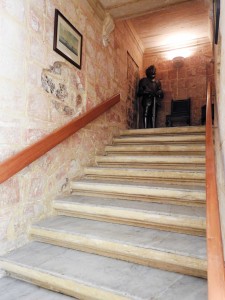 “Stone used for the building of the house was quarried on site. Once the building was complete, the resultant small quarry was used as a water cistern and basement. This process of cutting stones directly from Monte Sciberras hurried the process of the building of the new city.”
“Stone used for the building of the house was quarried on site. Once the building was complete, the resultant small quarry was used as a water cistern and basement. This process of cutting stones directly from Monte Sciberras hurried the process of the building of the new city.”“The facade of the palazzino was imposing, having a main door flanked by two others. The main entrance was decorated by a barrel vaulted ceiling, typical of the 16th century. Traces of a blocked arch located under the staircase which leads up to the piano nobile points out that originally, the level of the street was lower than it is today.”
“On 12th September 1634, a gunpowder magazine located in the whereabouts of the palazzino, blew up, killing 33 persons. The devastated site was left abandoned for thirty years until Grand Master Nicholas Cotoner established the Fondazione Cotoner in order to rebuild the houses in Strada San Paolo. The palazzino had suffered some cracks in the walls and its glass windows were shattered. Some structural changes were done to it, however, this structure was never intended to be built higher than two floors, since it would have been higher than the opposite building and would have cast a shadow on the University’s sundial.”
“Traces of red paint on the walls show that this building was painted in this colour. Meanwhile, the limestone balcony supports, the internal courtyard and the main staircase were adorned with seashell carvings that represented St John the Baptist, the patron saint of the Order of St. John. The seashell is also representative of the water element, in this case creativity and knowledge, as befits the University Rector’s house.”
It was a pleasure to explore this palazzino which I had never visited before. In the meantime, Garcia recounted some curiosities about the notable tenents who lived there.
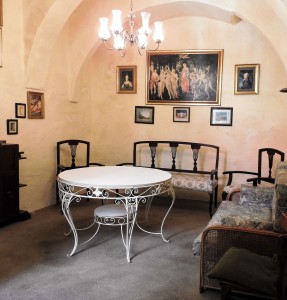 “In 1919, the tenant of Palazzino Sapienti was the lawyer Luigi Camilleri. On 7th June, 1919, Prince Lobanov-Rostovsky and Count Andrey Bobrinsky, both Russian Imperial refugees, were visiting Camilleri at his residence when suddenly the ‘Sette Guigno’ riots broke out. A large crowd made its way to the Royal Malta University and started to attack it, tearing down the English Imperial flag. These two Russian nobles who were witnessing this from the opposite palazzino were scared stiff since the remembrance of the Bolshevik revolution still haunted them. They stayed at the premises till the 12th June when they were escorted back to San Anton Palace in Balzan by Police Superintendent James Frendo Cumbo.”
“In 1919, the tenant of Palazzino Sapienti was the lawyer Luigi Camilleri. On 7th June, 1919, Prince Lobanov-Rostovsky and Count Andrey Bobrinsky, both Russian Imperial refugees, were visiting Camilleri at his residence when suddenly the ‘Sette Guigno’ riots broke out. A large crowd made its way to the Royal Malta University and started to attack it, tearing down the English Imperial flag. These two Russian nobles who were witnessing this from the opposite palazzino were scared stiff since the remembrance of the Bolshevik revolution still haunted them. They stayed at the premises till the 12th June when they were escorted back to San Anton Palace in Balzan by Police Superintendent James Frendo Cumbo.”“During the Second World War, the premises were used by the British Royal Air Force for the decoding of enemy aerial operations. Palazzino Sapienti survived two enemy bombs which were dropped in the vicinity. Yet tragedy still struck this place when two children, who were attending school in this building after the Valletta school was hit, found their way down a spiral staircase which led to the city’s undergrounds and got lost there. No one ever found them and these stairs have been blocked ever since.”
 Today, this building is also proud to possess three saint reliquaries: a first degree bone fragment from the Order’s Patron Saint St. John the Baptist, and two third degree relics in the form of a throne chair on which St. John Paul II sat during one of his Papal visits to Italy, and a hand signed dedication by Sister Mother Theresa of Calcutta who was also a member of the Order.
Today, this building is also proud to possess three saint reliquaries: a first degree bone fragment from the Order’s Patron Saint St. John the Baptist, and two third degree relics in the form of a throne chair on which St. John Paul II sat during one of his Papal visits to Italy, and a hand signed dedication by Sister Mother Theresa of Calcutta who was also a member of the Order.“Besides housing the Seat of the Order of St John of Jerusalem, Knight Hospitaller, Palazzino Sapienti has now opened its doors to the public who might be interested to visit it. Moreover lectures regarding various subjects are organized inside one of its rooms wherein we are also giving the opportunity to university students who would like to present talks about their studies or thesis.”
Certainly, an invitation to such a prestigious, architectural, and historical gem, should not be missed.
(This article was published in ‘Focus Valletta’ Suppliment issued with The Times of Malta dated 30 September 2015)
-
A SPECTACULAR WONDERLAND
Travelling at an impressive 300km/hr, a high-speed railway train took 5 hours and a half to reach Shanghai from Beijing. The voyage was impeccably comfortable. The train station was huge and amazing. Yet the actual surprise was the sheer difference between Beijing and Shanghai.
 Traffic in Beijing was crazy but we had hardly left Shanghai’s train station when we were already blocked behind a long queue of cars. This is no wonder if one considers that about 24 million people live in this city. Recent modernization and progress in Shanghai have attracted many persons and in the last five years, the population tripled itself.
Traffic in Beijing was crazy but we had hardly left Shanghai’s train station when we were already blocked behind a long queue of cars. This is no wonder if one considers that about 24 million people live in this city. Recent modernization and progress in Shanghai have attracted many persons and in the last five years, the population tripled itself.Along the road, we observed that plain residential high rises were wide to an extreme. Besides them, luxurious or commercial high rises glistened beautifully as if in a bid to outshine the sun itself. Older traditional structures, together with buildings which formed part of the foreign concession areas, claimed the passers-by attention with their distinguished architecture.
Originally, a simple fishing village, Shanghai’s economy expanded rapidly once it was turned into a commercial port. Since at the time, traders could only use the sea or waterways as a means of transportation, Shanghai’s wide harbour began to attract numerous Chinese from various parts of China and also several foreigners. A society of immigrants started to flourish, each of which began to leave their influences in this new city.
In a few years, a large flat muddy area, overgrown with reeds, which was situated on the north bank of Huangpu River, was turned into a zone for foreigners and they named it the Bund. Starting from just a one-sided street, running in north-south direction, the location soon flourished with commercial buildings which increased further the significance and the economy of Shanghai.
 Yet in the mid-19th century, serious conflicts arose between the forces of Western countries and the Chinese, Qing dynasty, after China attempted to suppress the opium trade. Since the 18th century, foreign traders, particularly the British, had been illegally exporting opium which they imported from India. By the 19th century, this trade had grown dramatically, and the resulting widespread addiction in China began to cause serious social and economic disruption. Two Opium Wars broke out in which China was twice defeated and foreign concessions were established. It was in 1943, during the war between China and Japan, that the foreigners decided to abandon Shanghai.
Yet in the mid-19th century, serious conflicts arose between the forces of Western countries and the Chinese, Qing dynasty, after China attempted to suppress the opium trade. Since the 18th century, foreign traders, particularly the British, had been illegally exporting opium which they imported from India. By the 19th century, this trade had grown dramatically, and the resulting widespread addiction in China began to cause serious social and economic disruption. Two Opium Wars broke out in which China was twice defeated and foreign concessions were established. It was in 1943, during the war between China and Japan, that the foreigners decided to abandon Shanghai.Between the 1950s and the 1960s, some of the elder people who resided in Shanghai, proposed to the government to demolish these colonial buildings which reminded them of a bitter past. However eventually, it was decided to retain these structures since they represented a real part of the city’s history, even if painful.
 In the last 100 years, the Bund frontage buildings were repaired and reconstructed several times. Today, this area is embellished with prominent and elegant structures which contrast deeply with the opposite side of the Bund wherein some daring and bizarre high rises have been built. At night, the latter, turns into a spectacular wonderland as the colossal structures are fully illuminated in bright and colourful lights.
In the last 100 years, the Bund frontage buildings were repaired and reconstructed several times. Today, this area is embellished with prominent and elegant structures which contrast deeply with the opposite side of the Bund wherein some daring and bizarre high rises have been built. At night, the latter, turns into a spectacular wonderland as the colossal structures are fully illuminated in bright and colourful lights.A visit to this district which looks like a strange combination of London and New York, will reveal why it has become the symbol of Shanghai and the pride of many of its residents. Crowds of visitors gather daily at the Bund in order to enjoy the beautiful scenery on the Huangpu River which divides the old and the modern zones. Nonetheless, if one wants to enjoy the experience to the full, a night boat cruise is certainly recommended.
Our guide from Shanghai explained to us that this city has changed tremendously in these last years. In 1987, there were only 12 high rise buildings in Shanghai, whereas today, there are around 140,000. People have more money in their pockets, education facilities have increased, and life is more comfortable especially due to the efficient and far-reaching subway system. Yet he felt that simultaneously, Shanghai citizens were losing some important characteristics of the city. Indeed, when elders returned to the city after living far away, they could not find their way around as a number of the old landmarks have gone or are engulfed amongst the different modern landscape.
 The repercussions of the sudden modernization of Shanghai have always been the focus of the authorities which are trying their very best to mitigate the impact of such changes. Their plans and projects are comprehensively described in the vast exhibitions which are displayed at the Shanghai Urban Planning Exhibition Hall which is located at the People’s Square. The centrepiece of the exhibition is a huge scale model of the city which shows all the existing and approved buildings. Moreover, a circular screen provides visitors with the opportunity to enjoy a fascinating 3D virtual tour around the city of Shanghai.
The repercussions of the sudden modernization of Shanghai have always been the focus of the authorities which are trying their very best to mitigate the impact of such changes. Their plans and projects are comprehensively described in the vast exhibitions which are displayed at the Shanghai Urban Planning Exhibition Hall which is located at the People’s Square. The centrepiece of the exhibition is a huge scale model of the city which shows all the existing and approved buildings. Moreover, a circular screen provides visitors with the opportunity to enjoy a fascinating 3D virtual tour around the city of Shanghai.Photo presentations explain how old buildings which were worth preserving and conserving, were carefully selected and restored, and then given a function in order to revive them. A particular example is the M50 contemporary art district which up to a few years ago was a disused industrial space. Another is the pedestrian walkway of Nanjing Road wherein 100 year old shops were amalgamated with new structures from where now, one can find speciality products of different trades standing next to famous brands.
 In Shanghai Old Street, which was reconstructed according to traditional Chinese style, visitors can roam around Yuyuan Market and absorb the allure of earlier times, whereas the nearby Yuyuan Gardens provide the beauty and serenity of a green environment. In the outskirts of Shanghai, ancient towns, such as Zhujiajiao, represent life of a distant and far simpler period in Shanghai. Concentrated under Shanghai’s Expo2010 motto ‘Better City, Better Life’, the main message of this place is to urge people to be proud as well as protective of their new city.
In Shanghai Old Street, which was reconstructed according to traditional Chinese style, visitors can roam around Yuyuan Market and absorb the allure of earlier times, whereas the nearby Yuyuan Gardens provide the beauty and serenity of a green environment. In the outskirts of Shanghai, ancient towns, such as Zhujiajiao, represent life of a distant and far simpler period in Shanghai. Concentrated under Shanghai’s Expo2010 motto ‘Better City, Better Life’, the main message of this place is to urge people to be proud as well as protective of their new city.A delightful wider look at the landscape of the city of Shanghai can be appreciated at a choice of revolving restaurants which are available on high towers. Definitely a surreal experience which gives you the ultimate impression of being on a totally different planet.
(This article was published in Escape Suppliment of The Sunday Times of Malta dated 13th September 2015)
-
L-attakk fuq l-isperun tal-Isla
Għal dawk kollha li tinteressahom l-Istorja ta’ Malta, din is-sena hija waħda sinifikattiva ħafna, peress li qed jiġi kkommemorat l-450 anniversarju mill-Assedju l-Kbir li seħħ fil-gżejjer tagħna fl-1565. Diversi kotba, lekċers, blogs, u attivitajiet relatati ma’ din it-tema, qegħdin ikomplu jqanqlu l-entużjażmu sabiex wieħed isir jaf aktar dwar din il-battalja qalila, fosthom għaliex seħħet, kif żvolġiet, min ħa sehem, x’kienu l-istrateġiji użati, u kif finalment il-Kavallieri ta’ San Ġwann u l-Maltin ħarġu rebbieħa akkost id-diffikultajiet kollha.
Sabiex jirrakkuntaw dawn il-fatti, nibtu wkoll numru ta’ paġni fuq Facebook u permezz tagħhom, wieħed jista’ jara biċ-ċar li mhumiex il-Maltin biss li qed jinvolvu ruħhom f’din il-kommemorazzjoni, imma anki għadd ta’ individwi minn madwar id-dinja kollha. B’hekk, din il-ġrajja tal-Assedju, qed isservi wkoll biex tiġbed l-attenzjoni tal-barranin lejn il-gżejjer tagħna u possibilment, uħud minnhom jafu jitħajjru jżuruna.
Mudell li juri l-attakk fuq l-isperun tal-Isla
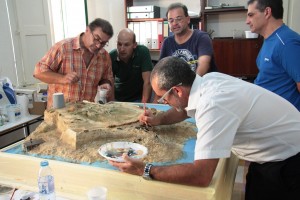 Waħda minn dawn il-paġni tal-Facebook hija ‘The assault on the Spur, Isla, 15th July 1565’ li permezz ta’ bosta ritratti, qed turi u tispjega pass pass, it-tnissil u l-kostruzzjoni ta’ diorama, jew mudell, tal-isperun tal-Isla. Għall-ewwel, segwejt dan il-grupp permezz tar-ritratti li kien qed itella’. Iżda eventwalment, tant sibt ix-xogħol li kien qed jitwettaq intriganti, li deherli li kien jixraq li mmur nagħtih titwila ħalli narah b’għajnejja.
Waħda minn dawn il-paġni tal-Facebook hija ‘The assault on the Spur, Isla, 15th July 1565’ li permezz ta’ bosta ritratti, qed turi u tispjega pass pass, it-tnissil u l-kostruzzjoni ta’ diorama, jew mudell, tal-isperun tal-Isla. Għall-ewwel, segwejt dan il-grupp permezz tar-ritratti li kien qed itella’. Iżda eventwalment, tant sibt ix-xogħol li kien qed jitwettaq intriganti, li deherli li kien jixraq li mmur nagħtih titwila ħalli narah b’għajnejja.“Huma ħafna dawk li qed juru x-xewqa li jiġu jaraw dan il-mudell,” stqarr Alex Schembri, President ta’ Society for Scale Modellers – IPMS Malta. “Napprezzaw ferm li l-pubbliku qiegħed isegwi x-xogħol tagħna b’tant ħeġġa u qed nagħmlu minn kollox biex sal-15 ta’ Lulju, inkunu nistgħu nvarawh ftit billi nippreżentaw diversi ritratti tiegħu.”
Society for Scale Modellers – IPMS Malta
Society for Scale Modellers ġiet imwaqqfa f’Jannar tal-1981. L-għan prinċipali ta’ dan il-klabb dejjem kien li jgħolli l-livell tal-iscale modelling f’pajjiżna sabiex jikkompara ma’ dak internazzjonali. Infatti l-klabb huwa affiljat mal-International Plastic Modellers Society li għandha rappreżentanti tagħha f’diversi pajjiżi madwar id-dinja.
L-iscale modelling jieħdok sa fejn trid
“Għalkemm dan il-qasam ġeneralment jitqies bħala passatemp, aħna xorta waħda nagħtuh attenzjoni kbira billi naraw li x-xogħol isir bi professjonalità. Imma fir-realtà, l-iscale modelling jieħdok sa fejn trid u infatti fost il-membri, għandna numru minnhom li huma esperti tassew, tant li rebħu diversi kompetizzjonijiet barra minn Malta. Oħrajn saru jipproduċu l-prodotti tagħhom u jbiegħuhom.”
Kull sena, din is-Soċjetà ttella’ esebizzjoni bix-xogħolijiet li jkunu saru mill-membri tagħha u f’dak iż-żmien, ikun hemm numru ta’ nies li jitħajjru jingħaqdu magħha.
“Idealment l-età tal-membri tagħna tibda minn 17 il-sena sabiex wieħed jilħaq jitrawwem f’dan il-qasam. Niltaqgħu darba f’ġimgħa ħalli nuru x-xogħolijiet li qed nagħmlu u flimkien niddiskutu x’jista’ jsir aħjar. Hawnhekk kulħadd ikollu l-preferenzi tiegħu: min jaħdem il-mudelli tal-ajruplani, min il-figuri, min il-karozzi, oħrajn inġenji tal-baħar eċċ. U għalhekk, wieħed jgħin u jgħallem lill-ieħor sabiex il-mudell tiegħu ikun aktar perfett u komplet.”
Proġett li ġabar flimkien lill-membri kollha
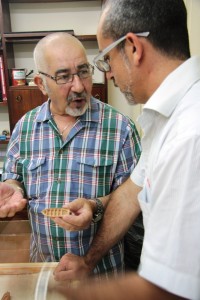 Fil-fatt, matul dawn l-aħħar xahrejn, prattikament il-membri kollha qegħdin jagħtu daqqa t’id biex jissawwar dan il-mudell imdaqqas tal-isperun tal-Isla.
Fil-fatt, matul dawn l-aħħar xahrejn, prattikament il-membri kollha qegħdin jagħtu daqqa t’id biex jissawwar dan il-mudell imdaqqas tal-isperun tal-Isla.L-għażla ta’ din it-tema oriġinat minn Ivan Cocker, wieħed mill-membri.
“Dehrilna li peress li dis-sena qed nikkommemoraw l-450 anniversarju mill-Assedju l-Kbir, kien jixraq li niddedikaw xi biċċa xogħol għalih. Wara li ddiskutejt din l-idea ma’ sħabi u mal-Kuraturi ta’ Heritage Malta, Emmanuel Magro Conti u Liam Gauci, l-għażla tagħna waqgħet fuq l-isperun tal-Isla minħabba li fuq dan il-Post ta’ Don Francisco de Sanoguera kien hemm il-konċentrament tal-attakk u anki peress li dan il-lwog kien l-uniku wieħed waqt dan l-assedju li ġiet attakkat kemm mill-art u kif ukoll mill-baħar,” spjegali Ivan.
Ir-riċerka nvoluta biex isir dan il-mudell
Hekk kif intagħżel il-lwog li kienu se joħolqu l-mudell tiegħu, bdiet riċerka sfieqa ħalli tinkiseb kemm jista’ jkun informazzjoni, l-aktar minħabba li llum ftit li xejn fadal minn dan l-isperun.
“Irreferejna ma’ għadd ta’ kotba, mapep, mużewijiet, u pitturi sabiex inkunu nistgħu noħolqu mudell kemm jista’ jkun viċin għal dak li kien jeżisti tassew f’dak il-perjodu. Ngħidu aħna biex bdejna nibnu l-isperun, imxejna mal-ktieb ta’ Balbi, li kien suldat li ħa sehem f’dan l-assedju. Rajna wkoll pjanti ta’ llum tal-Isla peress li sirna nafu li l-pedament tal-isperun għadu hemm. Fittixna wkoll kotba tal-istorja u tal-fortifikazzjonijiet li jsegwu dak li seħħ wara l-assedju ħalli b’hekk nagħrfu x’kienu dawk ix-xogħolijiet li saru wara, kemm mill-Kavallieri nfushom u kif ukoll mill-Imperu Ingliż.”
Mudell maħdum fuq skala 1:72
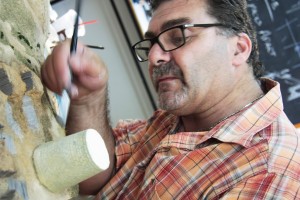 Huma użaw ukoll il-pjanti biex jiffurmaw l-iskala tal-mudell 1:72 ħalli b’hekk janalizzaw ukoll sa fejn se jkopri.
Huma użaw ukoll il-pjanti biex jiffurmaw l-iskala tal-mudell 1:72 ħalli b’hekk janalizzaw ukoll sa fejn se jkopri.“Ma stajnix nagħmlu l-Isla kollha, naturalment. Għalhekk iffukajna fuq l-isperun, u permezz tal-pjanti, ħriġna bl-iskala. Ħdimna b’reqqa kbira imma mbagħad kien hemm mument fejn kellna nagħlqu għajnejna. Dan seħħ per eżempju fil-każ tal-mitħna li fir-realtà kienet tinsab aktar lura minn fejn tidher fil-mudell. Madanakollu, peress li l-imtieħen lagħbu parti importanti f’din il-battalja, anki peress li biswiethom, l-Ordni kellha l-kanuni, ma kienx jagħmel sens li nħalluha barra,” infurmani Oliver Mifsud hekk kif beda jurini kif qed jinħadem dan il-mudell.
Sabiex il-mudell ma jkunx tqil wisq, il-pedamenti tiegħu tfasslu mill-ġablo u mbagħad fuqu beda l-kisi ta’ materjal ieħor ħalli jiġu ffurmati l-art u l-fortifikazzjoni. Imbagħad, biex il-lewn ta’ dawn jiġi jixbaħ lill-ġebla tal-franka Maltija, ġie xkatlat il-ġebel fil-wiċċ, mgħejjun ukoll miż-żebgħa ħalli joqrob aktar lejn ir-realtà.
Kull parti tal-mudell għandha l-istorja tagħha
Dawwruni ftit mal-mudell biex inkun nista’ nifli d-dettalji li fih. Intbaħt li skont minn fejn tħares lejn dan il-mudell, tkun tista’ ssegwi parti mill-ġrajja ta’ dak li seħħ f’dan il-post waqt l-assedju.
“Biex inkunu aktar preċiżi, segwejna wkoll mill-qrib kif saru l-attakki fuq dan l-isperun, ħalli b’hekk nagħrfu aħjar fejn saru l-ħsarat u t-tifrik, fejn tpoġġa ċertu lqugħ għad-difiża, fejn kien hemm il-katina biex iżżomm ix-xwieni tal-għadu milli jidħlu, u fejn il-Gran Mastru Jean de la Valette ordna biex isir l-ostaklu ġol-baħar li kellu jtellef lit-Torok milli jersqu bid-dgħajjes tagħhom,” qalli Ivan.
Minkejja t-tiftix u r-riċerka, xorta jibqgħu numru ta’ mistoqsijiet dwar uħud minn dawn li semmejt peress li issa għadda ħafna żmien u wieħed ikollu joqgħod biss fuq dak li jirnexxielu jsib.
Skoperti fatti kurjużi waqt il-ħidma ta’ dan il-mudell
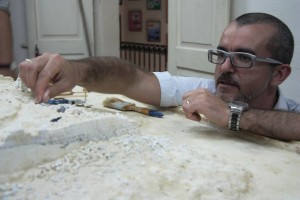 “L-ostaklu fil-baħar huwa eżempju minnhom,” fissirli Ivan. “Biex fassalnih, qgħadna ħafna fuq id-dettalji ta’ Balbi. Imma aħna u naħdmuh, ma stajniex nifhmu l-għala dan l-ostaklu ma sarx biex ikopri t-tul kollu tal-art imma tħalliet parti mikxufa minn fejn wieħed seta’ jidħol.”
“L-ostaklu fil-baħar huwa eżempju minnhom,” fissirli Ivan. “Biex fassalnih, qgħadna ħafna fuq id-dettalji ta’ Balbi. Imma aħna u naħdmuh, ma stajniex nifhmu l-għala dan l-ostaklu ma sarx biex ikopri t-tul kollu tal-art imma tħalliet parti mikxufa minn fejn wieħed seta’ jidħol.”“Intant, meta bqajna niflu dan id-dettall, sibna li fejn inbena l-ostaklu, il-baħar kien aktar baxx, filwaqt li fil-parti l-miftuħa, il-baħar kien fond. Għalhekk, komplejna deħlin nistħarrġu l-istorja u ma domnix ma skoprejna li għall-attakk tal-15 ta’ Lulju 1565 fuq dan l-isperun tal-Isla, il-Kmandanti Ottomani kienu bagħtu suldati li ma jafux jgħumu ħalli b’hekk ma jkunux jistgħu jirtiraw billi jgħumu lura.”
Uħud mill-membri li nġabru ħdejna ammettew illi qabel bdew jaħdmu fuq dan il-mudell, ftit li xejn kienu jafu dwar din il-parti tal-istorja ta’ Malta. Imma issa kien xort’oħra hekk kif bdew jinteressaw ruħhom dejjem aktar u l-għatx għall-informazzjoni kull ma jmur dejjem jikber.
Parti mill-mudell tal-mitħna maħdum minn disinjatur industrijali Amerikan
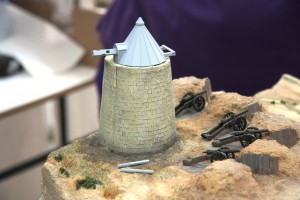 Biċċa xogħol oħra li qanqlet riċerka kienet il-mitħna.
Biċċa xogħol oħra li qanqlet riċerka kienet il-mitħna.“Ma stajniex noqogħdu biss fuq l-affreski ta’ D’Aleccio peress li fix-xogħolijiet tiegħu, dawn l-imtieħen ivarjaw. Jidher ċar li f’dan il-każ, l-artist uża l-immaġinazzjoni tiegħu u għalhekk aħna ridna nsibu x-xbieha reali tagħhom,” fissirli Alex.
“Inxtħetna nirriċerkaw dan is-suġġett u sibna li l-imtieħen tar-riħ ma kienux inbidlu wisq matul is-snin. Dorna anki diversi eżempji ta’ mtieħen li jinsabu hawn Malta u kif ukoll f’xi pajjiżi tal-Mediterran, sakemm finalment, ħriġna b’disinn li jqarreb kemm jista’ lejn l-oriġinal.”
Fatt li ta’ min isemmi huwa illi meta dan il-grupp wasal biex jaħdem din il-mitħna, il-parti ta’ fuq, li hija l-aktar diffikultuża, spiċċat saret minn sors li ma kienux qed jistennew.
“Kif taf inti, huma ħafna dawk li qed isegwu x-xogħol tagħna permezz tal-Facebook. Fosthom hemm Pete Hamann, disinjatur industrijali Amerikan, li tant apprezza dan il-proġett, li offra li jagħtina daqqa t’id. Hekk kif ġietna x-xoqqa f’moxtha, issuġġerejna li jaħdmilna l-parti ta’ fuq ta’ din il-mitħna li kienet tinsab fuq l-għolja tal-Isla u fi ftit taż-żmien, hu pprovdina bil-mudell 3D li ħadem apposta għalina.”
Numru kbir ta’ figuri jagħtu l-ħajja lill-mudell
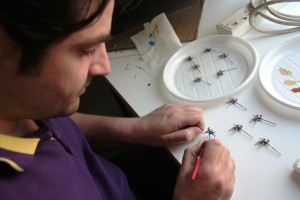 Dettall ieħor li jien apprezzajt ferm kien in-numru kbir ta’ figuri li kienu qed ikomplu jagħtu l-ħajja lil dan il-mudell. Skoprejt li kien hemm madwar 400 figura mqassma bejn Kavallieri u Ottomani.
Dettall ieħor li jien apprezzajt ferm kien in-numru kbir ta’ figuri li kienu qed ikomplu jagħtu l-ħajja lil dan il-mudell. Skoprejt li kien hemm madwar 400 figura mqassma bejn Kavallieri u Ottomani.“Dawk xtrajnihom bħala kits u issa qed niżbugħhom skont il-perjodu,” urini Alex hekk kif tani f’idejja numru minnhom.
Id-dettall li kien fihom kien straordinarju u bla dubju maħdum b’ħila u b’paċenzja kbira.
Mudell li jgħinek tara l-Istorja b’għajnejk
Bħala waħda minn dawk li qed insegwi ġurnata b’ġurnata l-ġrajja tal-Assedju l-Kbir, nistqarr li apprezzajt ferm il-possibilità li nara b’għajnejja dan il-mudell u nifli d-dettalji li fih, hekk kif permezz tiegħu, stajt nifhem aħjar dak li kont qed naqra dwaru.
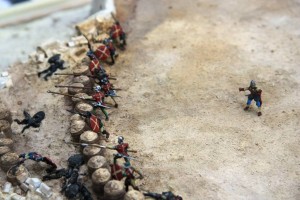 “Meta jitlesta dan il-mudell, nixtiequ ħafna nagħtuh bħala donazzjoni lil Heritage Malta sabiex b’hekk huwa jkun jista’ jservi bħala għodda edukattiva kemm għall-istudenti u kif ukoll għall-pubbliku li jżuru. Qed nittamaw li forsi dan il-mudell ikun jista’ jiġi nvolut ukoll fl-esebizzjoni internazzjonali li Heritage Malta se tkun qed torganizza fil-Palazz tal-Gran Mastru l-Belt bejn l-4 ta’ Settembru u s-6 ta’ Diċembru 2015.”
“Meta jitlesta dan il-mudell, nixtiequ ħafna nagħtuh bħala donazzjoni lil Heritage Malta sabiex b’hekk huwa jkun jista’ jservi bħala għodda edukattiva kemm għall-istudenti u kif ukoll għall-pubbliku li jżuru. Qed nittamaw li forsi dan il-mudell ikun jista’ jiġi nvolut ukoll fl-esebizzjoni internazzjonali li Heritage Malta se tkun qed torganizza fil-Palazz tal-Gran Mastru l-Belt bejn l-4 ta’ Settembru u s-6 ta’ Diċembru 2015.”Infatti mill-ġimgħa d-dieħla, fil-blog tal-Assedju l-Kbir ta’ Heritage Malta, www.heritagemalta.org/1565, wieħed se jkun jista’ jibda jiskopri uħud mill-oġġetti li se jkunu qed jiġu esebiti f’din l-esebizzjoni, li hi maħsuba li se tkun waħda mill-avvenimenti l-aktar importanti ta’ din is-sena relatati mal-ġrajja tal-Assedju tal-1565.
Aktar tagħrif dwar Society for Scale Modellers – IPMS Malta jista’ jinkiseb minn SSM House, Sulphur Lane, Ħamrun, inkella permezz tas-sit www.ipmsmalta.com u l-email info@ipmsmalta.com, jew permezz tal-Facebook.
(Dan l-artiklu ġie ppubblikat fis-sensiela MINN RITRATT (17 il-Parti) fit-Torċa tat-12 ta’ Lulju 2015)
-
L-età ġusta biex isir is-sess
Jafu li qed jiksru l-liġi?
 Probabbilment uħud minnkhom jiggustaw jaraw ritratti bħal dawn ta’ żgħażagħ jiskopru l-ewwel imħabba tagħhom. Kuntrarjament, ċerti ġenituri, speċjalment dawk ta’ tfajliet żgħar, jafu jitmeżmżu b’immaġni bħal dawn għax ma jridux jaraw lil uliedhom f’età daqstant żagħżugħa, diġà f’relazzjoni intima. Min-naħa l-oħra, iż-żgħażagħ infushom, fosthom dawk ta’ taħt it-18 il-sena, aktarx se jqisu esperjenzi bħal dawn bħala affaxxinanti u mixtieqa. Iżda minn dawn kollha li semmejt hawn fuq, kemm minnhom huma konxji li dawn iż-żgħażagħ li qed ikunu intimi bejniethom f’età ta’ inqas minn 18 il-sena, qegħdin fil-fatt jiksru l-liġi ta’ Malta?
Probabbilment uħud minnkhom jiggustaw jaraw ritratti bħal dawn ta’ żgħażagħ jiskopru l-ewwel imħabba tagħhom. Kuntrarjament, ċerti ġenituri, speċjalment dawk ta’ tfajliet żgħar, jafu jitmeżmżu b’immaġni bħal dawn għax ma jridux jaraw lil uliedhom f’età daqstant żagħżugħa, diġà f’relazzjoni intima. Min-naħa l-oħra, iż-żgħażagħ infushom, fosthom dawk ta’ taħt it-18 il-sena, aktarx se jqisu esperjenzi bħal dawn bħala affaxxinanti u mixtieqa. Iżda minn dawn kollha li semmejt hawn fuq, kemm minnhom huma konxji li dawn iż-żgħażagħ li qed ikunu intimi bejniethom f’età ta’ inqas minn 18 il-sena, qegħdin fil-fatt jiksru l-liġi ta’ Malta?Propost tibdil fil-liġi relatat mal-attività sesswali taż-żgħażagħ
Dan l-aħħar Dr Etienne Grech li huwa Membru Parlamentari, Ċermen tal-Kumitat Parlamentari tas-Saħħa u tabib tal-familja, ħareġ bil-proposta li għandha tiġi kkunsidrata d-dekriminilizazzjoni tal-attività sesswali bejn il-minuri fl-età bejn it-13 u l-15 il-sena. Dan meta bħalissa għaddejjha wkoll diskussjoni jekk l-Età tal-Kunsens Sesswali għandiex titnaqqas minn 18 għal 16 il-sena.
“Nistqarr li għall-ewwel, suġġeriment bħal dan, jaf jaħsad lil ħafna minħabba li se jkun hemm min jaħseb li se niftħu l-bieb għall-libertinaġġ sesswali,” spjegali Dr Grech. “Imma ninsab ċert li meta wieħed jixtarr ir-raġunijiet wara proposta bħal din, ikun jista’ jifhem u japprezza aktar il-bażi wara dan l-argument.”
 “Minn studji li qegħdin isiru, qegħdin naraw biċ-ċar illi mill-età ta’ 14 il-sena, numru konsiderevoli ta’ żgħażagħ qegħdin ikollhom relazzjonijiet sesswali kemm bejniethom u kif ukoll ma’ individwi ta’ età akbar. Fl-istess ħin qegħdin nirrealizzaw ukoll, illi ħafna minn dawn lanqas biss għandhom l-iċken idea li b’dan l-aġir tagħhom huma jkunu qed jiksru l-liġi; hekk kif il-liġi tagħna ma tagħtix kunsens lil dawk ta’ anqas minn 18 il-sena li jkollhom atti sesswali. Jintebħu b’dan biss jekk xi ħadd mill-ġenituri jippreżenta xi kwerela u minn hemm jibda l-inkwiet.”
“Minn studji li qegħdin isiru, qegħdin naraw biċ-ċar illi mill-età ta’ 14 il-sena, numru konsiderevoli ta’ żgħażagħ qegħdin ikollhom relazzjonijiet sesswali kemm bejniethom u kif ukoll ma’ individwi ta’ età akbar. Fl-istess ħin qegħdin nirrealizzaw ukoll, illi ħafna minn dawn lanqas biss għandhom l-iċken idea li b’dan l-aġir tagħhom huma jkunu qed jiksru l-liġi; hekk kif il-liġi tagħna ma tagħtix kunsens lil dawk ta’ anqas minn 18 il-sena li jkollhom atti sesswali. Jintebħu b’dan biss jekk xi ħadd mill-ġenituri jippreżenta xi kwerela u minn hemm jibda l-inkwiet.”Hija kontra l-liġi li tabib jeżamina individwu taħt it-18 il-sena mingħajr il-preżenza ta’ adult
Iżda b’tagħrif bħal dan u minħabba li hu tabib tal-familja, Dr Grech huwa konxju li din il-kwistjoni għandha riperkussjonijiet oħra.
“Hija wkoll kontra l-liġi li tabib jeżamina jew jagħti trattament lil individwi li għadhom m’għalqux it-18 il-sena, jekk ma jkunux akkumpanjati mill-ġenituri tagħhom jew minn xi adult responsabbli minnhom,” fehemni Dr Grech.
“Għaldaqstant, jekk tiġi tfajla ta’ taħt it-18 il-sena weħidha għandi u tistaqsini biex ninfurmaha dwar il-kontraċettivi jew biex nagħtiha r-riċetta ħalli tixtri kontraċettiv, jiena mistenni li nirrifjuta li ngħinha. Jekk le, inkun qed nikser il-liġi. Issa immaġina din is-sitwazzjoni fejn tfajla qed tgħidlek biċ-ċar li għandha l-intenzjoni li jkollha att sesswali u qed titlob biex tieħu prekawzjoni u inti trid tgħalqilha l-bieb f’wiċċha. Taħseb li billi inti ma tipprovdihiex b’kontraċettiv, lil din se twaqqafha milli tmur tagħmel li għandha tagħmel, jekk hemm bżonn anki mingħajr il-protezzjoni li xtaqet?”
Żgħażagħ li jiddarsu mill-preżenza tal-ġenituri
“Għalkemm individwi ta’ din l-età jkunu lesti li jersqu għand tabib tal-fiduċja tagħhom biex jistaqsu għal pariri bħal dawn, uħud mill-istess żgħażagħ mhu se jitkellmu qatt dwar dan is-suġġett fil-preżenza ta’ xi ħadd mill-ġenituri tagħhom. U b’hekk is-sitwazzjoni kif inhi, qed titfagħhom f’riskju ta’ mard sesswali, tqala mhux mixtieqa u problemi oħra.”
Fil-fatt, waqt punti relatati li tqajjmu mill-Kunsill Nazzjonali Żgħażagħ intqal illi jekk titnaqqas l-età tal-kunsens sesswali u b’hekk dawn it-tip ta’ relazzjonijiet ma jibqgħux jitqiesu bħala illeċiti, probabbilment aktar żgħażagħ ser ikunu lesti li jfittxu informazzjoni adegwata mingħand nies professjonali. Madanakollu, huma saħqu wkoll illi tibdil bħal dan jista’ jpoġġi f’riskju akbar lil nies vulnerabbli, u li għalhekk il-leġiżlazzjoni tal-protezzjoni tat-tfal għandha tkompli tiġi nfurzata. Barra minn hekk, huma għafsu fuq il-bżonn ta’ aktar edukazzjoni dwar dawn it-temi sabiex iż-żgħażagħ ikunu kapaċi jsiru aktar assertivi ħalli jirriffjutaw azzjonijiet mhux mixtieqa.
Malta fost il-ftit pajjiżi bl-ogħla età tal-kunsens sesswali fl-Ewropa
Dwar dan is-suġġett, Dr Joanne Cassar, lekċerer fil-qasam tal-Istudji taż-Żgħażagħ u l-Kommunità, ippreżentat xi punti sinifikanti minn servej nazzjonali li sar fl-2012 mill-Ministeru tas-Saħħa bl-isem ‘Tagħrif Sesswali, Attitudnijiet u Kondotti’. Fost ir-riżultati ta’ dan l-istħarriġ ġie indikat illi 41% taż-żgħażagħ Maltin ta’ età bejn 16 u 18 il-sena diġà kellhom relazzjoni sesswali. Fost ir-raġunijiet prinċipali l-għala sar l-ewwel att sesswali, iż-żgħażagħ irrispondew hekk: 47.5% għax kienu jħobbu s-sieħeb/sieħba tagħhom; 44.7% għax dak kien il-pass naturali li kien imiss fir-relazzjoni tagħhom; u 25.4% għax ħassew li kellhom l-età ġusta biex ikollhom din l-esperjenza. Minn dawn 41.6% użaw il-kondom waqt l-ewwel relazzjoni sesswali tagħhom, mentri l-oħrajn ma ħadu l-ebda prekawzjoni. Fost dawn iż-żgħażagħ li kellhom relazzjoni sesswali, 82.5% qablu li jeħtieġ li tkun tħobb lis-sieħeb/sieħba tiegħek biex tagħmel dan l-att. Intant, din ir-riċerka uriet ukoll illi fost il-pajjiżi Ewropej, Malta, it-Turkija u l-Vatikan kellhom l-ogħla età, dik ta’ 18 il-sena, f’dak li hu kunsens sesswali. Biex insemmi xi pajjiżi oħra: fi Spanja, din l-età tinżel għal 13; fil-Ġermanja, 14; fl-Iżvezja 15; fl-Iżvizzera, 16; u fl-Irlanda, 17.
Ma tistax titfa’ liż-żgħażagħ kollha f’keffa waħda
 Cassar qalet illi meta l-attività sesswali titqies bħala xi ħaġa tajba miż-żgħażagħ ta’ 16 il-sena, dan l-aġir jista’ jiġi kkunsidrat bħala parti mill-iżvilupp tagħhom bħala individwi. L-esplorazzjoni tagħhom fil-qasam tas-sesswalità tgħinhom jistabilixxu sens akbar ta’ identità hekk kif huma jkunu qed jesperjenzaw is-sodisfazzjon tal-intimità sesswali u ta’ relazzjonijiet interpersonali. Skont din il-perspettiva, stqarret Cassar, mhux addattat li wieħed jikkriminalizza lil dawn iż-żgħażagħ minħabba l-atteġġjament sesswali tagħhom. Iżda min-naħa l-oħra, hija semmiet li wieħed ma jistax jitfa’ ż-żgħażagħ kollha f’keffa waħda peress li mbagħad issib ukoll individwi tal-istess età li għalihom esperjenza ta’ relazzjoni sesswali lanqas biss joħolmu li jgħixuha għalissa, għax mhumiex lesti għaliha u għax pjuttost hi xi ħaġa li tbeżżagħhom.
Cassar qalet illi meta l-attività sesswali titqies bħala xi ħaġa tajba miż-żgħażagħ ta’ 16 il-sena, dan l-aġir jista’ jiġi kkunsidrat bħala parti mill-iżvilupp tagħhom bħala individwi. L-esplorazzjoni tagħhom fil-qasam tas-sesswalità tgħinhom jistabilixxu sens akbar ta’ identità hekk kif huma jkunu qed jesperjenzaw is-sodisfazzjon tal-intimità sesswali u ta’ relazzjonijiet interpersonali. Skont din il-perspettiva, stqarret Cassar, mhux addattat li wieħed jikkriminalizza lil dawn iż-żgħażagħ minħabba l-atteġġjament sesswali tagħhom. Iżda min-naħa l-oħra, hija semmiet li wieħed ma jistax jitfa’ ż-żgħażagħ kollha f’keffa waħda peress li mbagħad issib ukoll individwi tal-istess età li għalihom esperjenza ta’ relazzjoni sesswali lanqas biss joħolmu li jgħixuha għalissa, għax mhumiex lesti għaliha u għax pjuttost hi xi ħaġa li tbeżżagħhom.Jeħtieġ tissaħħaħ l-edukazzjoni dwar is-sesswalità u s-saħħa riproduttiva
Anki l-psikoterapista Amanda Grech taqbel li għandu jinħoloq bilanċ bejn li nsegwu lil dawn iż-żgħażagħ imma li fl-istess ħin, inħallulhom l-ispazju fejn jikbru. Hija spjegat kif skont ċerti studji li saru jidher illi jeżistu numru ta’ fatturi li jistgħu jbassru l-possibilità li xi żgħażagħ jistgħu jidħlu għal relazzjoni sesswali kmieni ħafna fil-ħajja. Fost dawn hemm dawk li jgħixu ma’ ġenitur wieħed, dawk li għandhom ġenituri b’attitudni sesswali permessiva, u dawk li kienu vittmi ta’ esperjenzi trawmatiċi waqt it-tfulija tagħhom, partikolarment f’każ ta’ abbuż sesswali. Għaldaqstant, hija tirrakkommanda illi għandha tissaħħaħ aktar l-edukazzjoni dwar is-sesswalità u s-saħħa riproduttiva, u li din għandha tiffoka partikolarment fuq it-tip ta’ familji li semmiet fuq. Barra minn hekk, jgħin ukoll jekk tingħata iżjed għajnuna relatata mat-tagħlim tal-kapaċitajiet ġenitorjali ħalli b’hekk ikun hemm aktar ġenituri mgħarrfa dwar dan il-qasam.
Tista’ tiżżewweġ ta’ 16 imma twettaq is-sess ta’ 18
Dun Joseph Mizzi, id-Direttur ta’ Kana, irrimarka wkoll dwar id-diskrepanza li teżisti bħalissa fejn wieħed jista’ jiżżewweġ fl-età ta’ 16 il-sena, jekk ikollu l-permess tal-ġenituri tiegħu, imma fl-istess ħin imbagħad teżisti liġi oħra li tgħid li l-età tal-kunsens sesswali hija dik ta’ 18 il-sena. U din ir-realtà toħloq inkonsistenza u konfużjoni.
Min-naħa l-oħra, huwa tkellem ukoll dwar il-preokkupazzjoni li jekk titbaxxa l-età tal-kunsens sesswali, dan jista’ jinċentiva u jħajjar aktar attività sesswali barra miż-żwieġ. Għaldaqstant huwa saħaq illi f’każ li titbaxxa din l-età, l-istat, il-Knisja, l-NGOs, u l-korpi kollha konċernati m’għandhom qatt jieqfu mill-kampanja soda u intensiva ta’ edukazzjoni u formazzjoni tal-karattru tat-tfal, l-adoloxxenti u ż-żgħażagħ tagħna. Fl-opinjoni ta’ Mizzi, is-suġġett tal-Personal, Social and Careers Development (PSCD) li qed jiġi mgħallem fl-iskejjel tagħna, qed imiss wisq ħafif ħafif mat-tema tas-sesswalità u b’hekk jiddubita kemm huwa effettiv.
Ma jemminx li s-soluzzjoni tinsab fit-tnaqqis tal-età tal-kunsens
Min-naħa tiegħu, George Buttigieg, Konsulent fl-Ostretiċija u Ġinekologu, jelenka dawn l-erbgħa argumenti favur li l-età tal-kunsens sesswali titniżżel għal 16 il-sena:
- li Malta tiġi uniformi mal-parti l-kbira tal-Ewropa;
- li din il-bidla tirrifletti l-aġir sesswali taż-żgħażagħ Maltin fil-preżent;
- l-eliminazzjoni jew tnaqqis ta’ każijiet li jitressqu quddiem il-qrati taħt l-Att 203 (sitwazzjonijiet li umanament ma jagħmlux sens iżda li jistgħu jitressqu la l-liġi hi kif inhi); u
- il-faċilità tal-kura medika assoċċjata ma’ problemi sesswali fiż-żgħażagħ taħt it-18 il-sena li ma jersqux liberament għal din il-kura.Madanakollu, Buttigieg ma jemminx li s-soluzzjoni tinsab fit-tnaqqis tal-età tal-kunsens imma li jingħata għarfien u saħħa lill-prinċipju tal-age banding li jgħaqqad ir-rispett tan-natura umana fis-seklu 21 flimkien mal-ħarsien tal-vulnerabbilità sesswali taż-żgħażagħ tagħna.
L-ebda liġi mhu se twaqqaf liż-żgħażagħ milli jwettqu s-sess
 Fil-fehma tiegħu, bosta żgħażagħ m’humiex konxji minn dak li tgħid il-liġi. Iżda anki jekk ikunu jafu, ma jaħsibx li dawn se jagħtu każ jew li se jibżgħu mill-liġi. Lanqas ma jaħseb li jekk tinżel l-età tal-kunsens sesswali għal 16 il-sena, se tiżdied aktar it-tqala fost iż-żgħażagħ għax fir-realtà, jidhirlu li qegħdin f’dinja fejn kulħadd jagħmel dak li jfettillu bla ma joqgħod jagħti każ x’jgħidu t-tobba jew il-politikanti.Personalment, fir-realtà li qed ngħixu fiha, l-aktar ħaġa neċessarja b’mod immedjat hija li niffaċilitaw l-aċċess għall-għajnuna medika għaż-żagħżagħ ta’ 16 il-sena billi nħalluhom fil-libertà li jmorru għand tabib għall-kontraċezzjoni, pariri relatati u kura ta’ mard li jista’ jirriżulta mill-attività sesswali.
Fil-fehma tiegħu, bosta żgħażagħ m’humiex konxji minn dak li tgħid il-liġi. Iżda anki jekk ikunu jafu, ma jaħsibx li dawn se jagħtu każ jew li se jibżgħu mill-liġi. Lanqas ma jaħseb li jekk tinżel l-età tal-kunsens sesswali għal 16 il-sena, se tiżdied aktar it-tqala fost iż-żgħażagħ għax fir-realtà, jidhirlu li qegħdin f’dinja fejn kulħadd jagħmel dak li jfettillu bla ma joqgħod jagħti każ x’jgħidu t-tobba jew il-politikanti.Personalment, fir-realtà li qed ngħixu fiha, l-aktar ħaġa neċessarja b’mod immedjat hija li niffaċilitaw l-aċċess għall-għajnuna medika għaż-żagħżagħ ta’ 16 il-sena billi nħalluhom fil-libertà li jmorru għand tabib għall-kontraċezzjoni, pariri relatati u kura ta’ mard li jista’ jirriżulta mill-attività sesswali.Il-professjoni medika qiegħda tiġi mxekkla mill-liġi
Ċertament, dan l-aħħar argument tqajjem ukoll mill-Kunsill Mediku ta’ Malta minħabba li bħalissa, il-professjoni medika qiegħda tiġi mxekkla mill-liġi milli tgħin lil dawn iż-żgħażagħ f’dak li għandu x’jaqsam mas-saħħa sesswali, peress li kif diġà semmejt qabel, mhux permess li tabib jara żagħżagħ taħt it-18 il-sena mingħajr il-preżenza ta’ adult. B’hekk, kemm is-saħħa sesswali taż-żgħażagħ u kif ukoll il-kommunità nnifisha qegħdin ikunu f’riskju, anki għax individwi li jkollhom xi problemi ta’ mard jew infezzjonijiet relatati mas-sess, ma jistgħux jersqu għand tabib u b’hekk tinħoloq ħafna tbatija inutli u tixrid ta’ dan il-mard mhux ikkurat.Wasal iż-żmien li naffaċċjaw ir-realtàBħala ġenituri taż-żgħażagħ tagħna, huwa ideali li nibqgħu noħolmu li wliedna se jistennew l-età ġusta sabiex ikollhom l-ewwel esperjenza ta’ relazzjoni sesswali. Madanakollu, ir-riċerka li qed issir qiegħda turi realtà differenti fejn numru konsiderevoli taż-żgħażagħ ta’ llum qegħdin jiddeċiedu li jwettqu dan l-att, akkost il-konsegwenzi kollha li jista’ jkun hemm, bħall-mard u tqala mhux mixtieqa. B’hekk, naħseb li ta’ min li wieħed jirrifletti kemmxejn dwar l-argumenti li saru hawn fuq mill-esperti konċernati.
-
Mad-daqq tal-banda
Sa mill-ibgħad snin tal-eżistenza tiegħu, il-bniedem kien affaxxinat bil-kapaċità tiegħu li joħloq ħoss, liema abbiltà eventwalment evolviet fil-mużika. Maż-żmien, ġew żviluppati konsiderevolment anki l-istrumenti mużikali, sakemm illum, teżisti għażla vasta ta’ tipi differenti.
Firxa minn dawn l-istrumenti varji huma użati mill-baned tagħna li llum saru jiffurmaw parti mill-wirt kulturali tagħna. Infatti, ir-ritratti tal-bandisti Maltin saru sinomini mal-esebizzjonijiet fotografiċi li jkunu relatati mat-tradizzjonijiet u l-kultura lokali.
Hekk kif issa beda l-istaġun tal-festi, tħajjart nesplora kemmxejn id-dinja tal-banda u tal-bandisti. Kif stennejt, ħarġu dettalji u rakkonti tassew interessanti.
Il-festa tar-raħal isservi bħala xrara
 Il-folla numeruża kienet qed tifraħ u ċċapċap hekk kif l-istatwa tal-patruna tfaċċat glorjuża fil-bieb tal-parroċċa taż-Żejtun. Għadd ta’ bnadar kbar u kkuluriti kienu qed iżejjnu l-bjut tad-djar u tal-każini tal-madwar, iperpru sbieħ fis-sema kaħlana. It-tiżjin tat-triqat kompla jgħani din l-atmosfera ferriħija tal-festa li kienet qed tiġi ċċelebbrata. Iżda bla dubju, dan l-ambjent allegru kien jonqoslu ħafna mill-briju li kieku ma kienx għall-mużika sabiħa tal-banda.
Il-folla numeruża kienet qed tifraħ u ċċapċap hekk kif l-istatwa tal-patruna tfaċċat glorjuża fil-bieb tal-parroċċa taż-Żejtun. Għadd ta’ bnadar kbar u kkuluriti kienu qed iżejjnu l-bjut tad-djar u tal-każini tal-madwar, iperpru sbieħ fis-sema kaħlana. It-tiżjin tat-triqat kompla jgħani din l-atmosfera ferriħija tal-festa li kienet qed tiġi ċċelebbrata. Iżda bla dubju, dan l-ambjent allegru kien jonqoslu ħafna mill-briju li kieku ma kienx għall-mużika sabiħa tal-banda.Kien waqt mument distint bħal dan, lura f’Novembru tal-1973, meta Alexander Vella u ħuħ Raymond, flimkien ma’ grupp ta’ ħbieb oħra, iddeċidew li jibdew jagħmlu parti minn dan l-ispettaklu billi jingħaqdu maż-Żejtun Band Club. Alexander, li kellu 15 il-sena dak iż-żmien, jiftakar li missieru ħa gost ferm b’din l-aħbar, l-aktar minħabba li hu stess kien ilu membru f’din is-soċjetà għal bosta snin. Madanakollu, huwa ma naqasx milli jwissi lil uliedu li jekk tassew riedu jirnexxu f’dan il-qasam, huma kellhom jibdew mill-ewwel jieħdu l-affarijiet bis-serjetà u jintefgħu jistudjaw.
Opportunità għal min xtaq jitgħallem idoqq
Ma kienx diffiċli biex tiġi aċċettat bħala membru fiż-Żejtun Band Club peress li l-għan prinċipali ta’ din is-Soċjetà li twaqqfet fl-1933, minn dejjem kien li jagħti l-opportunità lil kull min xtaq jitgħallem idoqq xi strument tal-banda. Infatti, l-istudenti kienu jiġu mgħallma bla ħlas minn għalliema u maestros professjonali, u hekk kif kienu jaqbżu l-aspett teoretiku, is-Soċjetà kienet saħansitra tislifhom strument sabiex idoqqu bih. B’dan il-mod, is-Soċjetà kienet tispera li l-quddiem għad tħajjar lil dawn l-individwi biex jingħaqdu magħha bħala mużiċisti tal-banda, ħalli b’hekk din tkompli ssaħħaħ ir-reputazzjoni tagħha b’membri validi.
Ridt tkun tassew determinat biex tibqa’
 Ċertament, sa mill-ewwel lezzjoni, Vella ntebaħ li din ma kienetx se tkun biċċa xogħol faċli.
Ċertament, sa mill-ewwel lezzjoni, Vella ntebaħ li din ma kienetx se tkun biċċa xogħol faċli.“Ridt tkun tassew determinat li tingħaqad mal-banda biex tibqa’ għaddej bl-istudju, l-aktar għaliex qabel jagħtuk l-istrument li mingħalik kont se tibda ddoqq, kien jeħtieġlek titgħallem bl-amment in-noti tal-mużika,” stqarr Vella.
“Qatt qabel ma kont tgħallimt il-mużika u għalkemm kieku ried, missieri seta’ jħarriġni, huwa rriffjuta li jagħmel dan. Minflok insista li noqgħod attent waqt il-lezzjoni u li nisma’ sew x’kellu jgħidli l-għalliem. Niftakar li darbtejn biss azzardajt nistaqsih xi ħaġa wara li ma fhimtx x’għamilna fil-lezzjoni imma fiż-żewġ okkażżjonijiet, huwa ċanfarni u wissieni biex ma naħlix il-ħin tal-għalliem tiegħi. Wara dakinhar, qatt ma ppruvajt nistaqsih xi ħaġa oħra u kont nara li nifhem sew dak li jsir fil-klassi.”
Il-bużillis kien li din l-attitudni ddixxiplinata kienet teżisti anki fil-klassi
“L-għalliem tagħna, Edgar Lowell, kien maestro mill-aqwa imma kien bniedem tassew strett. Kien jippretendi li l-istudenti jattendu regolarment għall-lezzjonijiet u li jsegwuhom b’attenzjoni kbira. Ma ninsa qatt meta fl-ewwel lezzjoni, hu fetaħ idejh beraħ quddiemna u hekk kif beda jipponta lejn subgħajh, qalilna li Alla kien tana ħames swaba’ b’erbgħa spazji bejniethom sabiex niftakru dejjem li kien hemm disgħa noti mużikali bażiċi.”
Ridt tuża l-istint
“Minn dakinhar konna mistennija naħdmu iebes u nimxu ‘l quddiem mingħajr ma jkollna għalfejn nistaqsu wisq għall-għajnuna. Kellna nidraw nużaw l-istint tagħna u widnejna biex nifhmu l-ħsejjes u r-ritmi mużikali korretti. Żball wieħed waqt il-lezzjoni kien ikun biżżejjed biex l-għalliem jaqbdek u jibgħatek id-dar bla kliem u bla sliem ħalli tmur tistudja mill-ġdid id-dar. Dak iż-żmien, it-tifħir ma kienx jeżisti u kont tirrealizza biss li kont sejjer tajjeb meta l-għalliem kien jagħtik titgħallem in-noti li jmiss. Dak kollox!”
Wara erbgħa snin taħriġ, Vella beda jdoqq maż-Żejtun Band Club u ma damx ma beda jservi wkoll ma’ baned oħra. Illum, fl-età ta’ 53 sena, huwa għandu esperjenza ta’ 37 sena ma’ din il-banda u kapaċi jdoqq diversi strumenti. Bi gratitudni lejn din is-Soċjetà li tagħtu tant, fl-2012 hu flimkien ma’ martu Jane, rregalaw sett ta’ bandalori tal-bellus meħjutin bir-rakkmu tad-deheb, bħala tifkira tal-involviment tiegħu magħha, waqt iċ-ċelebrazzjoni tat-80 anniversarju mit-twaqqif tagħha.
Bidla fil-kultura
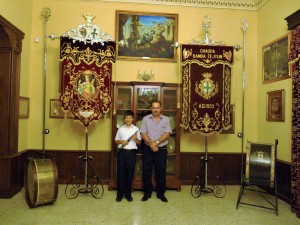 Maż-żmien dan l-atteġġjament inbidel kompletament, hekk kif stajt nifhem meta tkellimt ma’ Isaac Scicluna; tifel ta’ 11 il-sena li hu l-iżgħar bandist ta’ din is-soċjetà.
Maż-żmien dan l-atteġġjament inbidel kompletament, hekk kif stajt nifhem meta tkellimt ma’ Isaac Scicluna; tifel ta’ 11 il-sena li hu l-iżgħar bandist ta’ din is-soċjetà.Fatt kurjuż huwa li Scicluna tħajjar jissieħeb maż-Żejtun Band Club eżatt bl-istess mod kif ġralu Vella; jiġifieri, waqt il-festa ta’ Santa Katarina tal-2011. Bħal Vella, hu wkoll kellu xi membri tal-familja li kienu jdoqqu, fosthom lil missieru, lil nannuħ u lil bużnannuħ li kollha kienu bandisti ferventi. L-istess bħal sieħbu akbar minnu, Scicluna ħassu pjuttost konfuż meta fl-età ta’ 8 snin daħal għall-ewwel darba biex jitgħallem ma’ din is-Soċjetà u sab ruħu affaċċjat bin-noti tat-teorija flok bl-istrument li xtaq!
Iżda t-tixbiħ ma’ Vella s’hawn jieqaf peress li bil-bidla fil-kultura, li fil-preżent aktar tikkunsidra li tgħin milli li żżomm dixxiplina iebsa, huwa jsib għajnuna kbira kemm mill-ġenituri tiegħu u kif ukoll mill-għalliem meta jkollu bżonn l-assistenza tagħhom.
“Fl-ewwel lezzjoni ntroduċewni man-noti tal-mużika,” qalli Scicluna. “Ftit ftit bdejt nitgħallem isimhom, it-tip u l-valur tagħhom. Imbagħad ngħatajt sett noti mużikali u ġejt mitlub nikkupjahom u nistudjahom. Missieri għeni nsib it-triq sakemm ġejt fuq saqajja u stajt inkompli naħdem waħdi. Fir-realtà, anki jekk issib tant sapport, jiddependi ħafna mill-ambizzjoni tiegħek sabiex tirnexxi għax aktar ma jgħaddi ż-żmien, il-lezzjonijiet kull ma jmur jitqalu. Meta tkun għadek student l-iskola, jeħtieġlek ukoll titgħallem tqassam ħinek sewwa ħalli tlaħħaq mal-istudju tal-iskola u xorta ssib ħin x’tiddedika għall-banda.”
“Peress li jiena xellugi, kelli nderri lili nnifsi biex nitgħallem inżomm ir-ritmu b’saqajja l-leminija u ngħodd in-noti b’idejja l-leminija sabiex inkompli mal-bqija tal-grupp. Wara xi żmien nistudja, intlabt ukoll nibda nkanta n-noti ħalli b’hekk widnejja jintunaw ruħhom għall-mużika bi preparazzjoni għall-istrument li kont se ndoqq.”
Filwaqt li Vella dam aktar minn tliet snin jistudja t-teorija, Scicluna kien meqjus pront biex jitgħallem l-istrument f’nofs dak il-perjodu. Min-naħa l-oħra, mentri Vella ġie rrakkommandat idoqq is-saksafon peress li kien twil imma minflok għażel il-klarinett bħal dak li kien idoqq missieru, Scicluna li xtaq idoqq is-saksafon, kellu joqgħod għall-klarin peress li subgħajh għadhom wisq qosra għall-istrument l-ieħor.
L-iżgħar bandist
 Sadanittant, is-sena 2013 kienet waħda sinifikanti ferm għal Scicluna u l-familja tiegħu, meta hu ġie ntrodott bħala l-iżgħar bandist taż-Żejtun Band Club. Fatt interessanti huwa illi din iċ-ċelebrazzjoni kienet pjuttost insolita peress li s-soltu, bandist ġdid jiddaħħal fil-banda biss waqt iċ-ċelebrazzjonijiet tal-Ġimgħa l-Kbira. Iżda, minħabba l-mewt għall-għarrieda tal-arċipriet taż-Żejtun, Dun Eric Overend, bosta mill-attivitajiet kellhom jiġu posposti u b’hekk Scicluna ngħata l-opportunità li jdoqq għall-ewwel darba waqt il-Programm Mużikali Annwali tal-2013.
Sadanittant, is-sena 2013 kienet waħda sinifikanti ferm għal Scicluna u l-familja tiegħu, meta hu ġie ntrodott bħala l-iżgħar bandist taż-Żejtun Band Club. Fatt interessanti huwa illi din iċ-ċelebrazzjoni kienet pjuttost insolita peress li s-soltu, bandist ġdid jiddaħħal fil-banda biss waqt iċ-ċelebrazzjonijiet tal-Ġimgħa l-Kbira. Iżda, minħabba l-mewt għall-għarrieda tal-arċipriet taż-Żejtun, Dun Eric Overend, bosta mill-attivitajiet kellhom jiġu posposti u b’hekk Scicluna ngħata l-opportunità li jdoqq għall-ewwel darba waqt il-Programm Mużikali Annwali tal-2013.Nibqa’ ndoqq sal-aħħar
Illum, kemm Vella u Scicluna, huma ħerqana biex ikomplu jagħtu s-servizz tagħhom f’din il-banda u għalkemm hemm baħar jaqsam bejn l-età ta’ dawn iż-żewġ individwi, it-tnejn sostnew li xtaqu jkomplu jdoqqu sakemm Alla jibqa’ jagħtihom is-saħħa. Għalissa, Scicluna daqq biss maż-Żejtun Band Club iżda xorta waħda, hu diġà kellu ċ-ċans jieħu sehem f’funzjonijiet importanti bħal meta l-banda daqqet fil-funeral tal-eks-ministru, Wistin Abela.
Ir-rwol tal-banda
“Ir-rwol tal-banda hu li tferraħ in-nies bil-mużika tagħha,” qalli Vella. “Madanakollu, bħal f’kollox, anki din għandha l-lati diffiċli tagħha. Ngħidu aħna, għalkemm jiena nħobb nisma’ ħafna l-marċi funebri illi l-banda tagħna ddoqq waqt l-attivitajiet tal-Ġimgħa l-Kbira, meta nsib ruħi qiegħed nakkumpanja funeral bid-daqq tiegħi, inħossni emozzjonat. Minn dejjem kont hekk, imma din is-sensazzjoni kompliet tiżdied wara li kelli ndoqq waqt il-funeral ta’ missieri u hemm ħassejt l-uġiegħ u n-niket li kapaċi jiġi espress permezz tal-istrumenti differenti. Dakinhar, deherli li l-ħoss tagħhom kien jixbaħ il-bikja tas-soċjetà li kienet għadha kif tilfet lil wieħed mill-membri tagħha.”
Anki t-tfajjel Scicluna qabel ma dan.
“Jien ukoll inħossni daqsxejn skomdu meta jkolli ndoqq waqt funeral. Imma fl-istess ħin, jien konxju li bil-mużika tiegħi nkun qed nuri rispett lil dak l-individwu li jkun ħalliena. Xorta waħda nħares dejjem il-quddiem biex jiġi ż-żmien tal-festi meta nkunu nistgħu nferrħu n-nies bid-daqq tal-istrumenti tagħna.”
(Dan l-artiklu ġie ppubblikat fis-sensiela MINN RITRATT (14 il-Parti) fit-Torċa tal-21 ta’ Ġunju 2015)
Travelogue
Archives
| M | T | W | T | F | S | S |
|---|---|---|---|---|---|---|
| « Jan | ||||||
| 1 | 2 | 3 | 4 | 5 | ||
| 6 | 7 | 8 | 9 | 10 | 11 | 12 |
| 13 | 14 | 15 | 16 | 17 | 18 | 19 |
| 20 | 21 | 22 | 23 | 24 | 25 | 26 |
| 27 | 28 | 29 | 30 | 31 | ||
Recent Posts
- A MATTER OF FATE
- MALTA’S PREHISTORIC TREASURES
- THE MAGIC IS IN THE DETAIL
- THE SELLING GAME
- NEVER FORGOTTEN
- Ġrajjiet mhux mitmuma – 35 sena mit-Traġedja tal-Patrol Boat C23
- AN UNEXPECTED VISIT
- THE SISTERS OF THE CRIB
Comments
- Pauline Harkins on Novella – Li kieku stajt!
- admin on IL-KARNIVAL TRAĠIKU TAL-1823
- Albert on IL-KARNIVAL TRAĠIKU TAL-1823
- Martin Ratcliffe on Love in the time of war
- admin on 24 SENA ILU: IT-TRAĠEDJA TAL-PATROL BOAT C23